|
CITY COMMISSIONER DR.
SUMTER de LEON LOWRY, SR.
Sumter L. Lowry (Sr.) was born in 1861 in
York, South Carolina, a son of a Confederate Army surgeon. He studied
pharmacology at South Carolina Medical School College and worked as a
druggist before moving to Palatka, Fla. in 1888. There he had a pharmacy
and general store before moving to Tampa in 1894.
But long before the park, zoo and the
neighborhoods were named for him, Dr. Sumter L. Lowry built his house in
1895 in South Tampa. It was a clapboard house with Queen Anne elements,
and a short distance from Hillsborough Bay in Hyde Park North.
In Tampa, Dr. Lowry had great success
in the insurance business, becoming the Manager of Reliance Life
Insurance Company and the Director of Gulf Life Insurance Company. He
developed a keen interest in public service when the city adopted the
commission form of government. Lowry served three consecutive
terms as a Commissioner starting in 1922. (Jan. 3, 1922-Jan. 24, 1928.)
Dr. Lowry was instrumental in many
public improvements during his six years on the commission, He
played a key role in the purchase and installation of the city
waterworks and port improvements, he helped build Municipal Hospital on
Davis Islands (now Tampa General), he had roles in the rehabilitation of
the Tampa Bay Hotel (now University of Tampa) and the construction of
five bridges. Lowry also raised funds to build downtown's St.
Andrew's Episcopal Church and was a founder of St. John's Episcopal
Church in Old Hyde Park. When the Gandy Bridge was completed in
the fall of 1924, Lowry represented the City of Tampa with
Mayor-Commissioner Perry G. Wall at the opening ceremony.
Today, two neighborhoods carry his name
and the Lowry House is home to law offices at 333 S Plant Ave.
But WHY was Lowry
Park named for him?
|
|
|
| LOWRY PARK
BEGINNINGS
This is what you've
probably heard
about how Lowry Park came to be and why it was so named. The story
is found almost everywhere the park's beginnings are described...
In 1918, City Commissioner Dr. Sumter Lowry urged the city of Tampa
to buy land north of Sligh Avenue at North Blvd. and dedicate it for
use as a public park. In 1925, after years of hard work,
it became a reality, and the park was later named in Lowry's honor.
But
Lowry wasn't a City Commissioner in 1918, nor did he even hold any position
in city government at this time. In fact, the commission form of
city government was not adopted until a Nov. 1921 election and he wasn't a commissioner
until that form of government started on Jan. 3, 1922.
Some early
variations of this story say he donated the land for the purpose of
building a city park. This one below confuses Dr. Lowry (Sr.) with his
son, Gen. Lowry (Jr.) and credits him with donating the land. This
was said in a public speech by a direct descendant of Lowry:
Lt. Gen. Sumter Lowry, a city official in the 1920s...got parcels of
land together and donated it to the city to create a park.
None of the
above really happened.
|
|
HOW IT REALLY HAPPENED - A CEMETERY SITE
In late January of
1918, the Tampa
City Council
put aside rules and pushed an ordinance through to purchase 105 acres of
land from Eben E. Cone for $30,000. The proposition wasn't
discussed at this meeting which was the third reading of the
proposition, nor any suggestion made that the ordinance be handled under
the current rules of procedure. The only Councilman who opposed
the purchase was Ramon Sierra who voted "No" on each motion.
At this time (Jun. 6,
1916 – Jun. 10, 1920), the City Council consisted of President Fred W.
Ball, James B. Anderson, James E. Etzler, John R. Fielding, G. T.
Henderson, Henry P. Kennedy, Henry R. Lightfoot, Erwin R. Murray, Pedro
G. Ramos, Dr. David E. Saxton, and Ramon Sierra, Jr. (An election
was held on Jun. 4, 1918 and all members were reelected with no changes.)
The mayor was Donald B. McKay.
The members of the
Cemetery
Committee consisted of Councilmen J. E. Etzler, P. G. Ramos, and Henry
P. Lightfoot.
The land purchased
was located south of Sulphur Springs, on the west bank of the river
directly across from Dr. Goldstein's pool and was to be used
as a new City cemetery site. It was offered for sale to the
city a week before the above described meeting.
But there were no
decent roads from Tampa to this "remote" area. The last paragraph of the
article below describes just how difficult it was to reach the property.
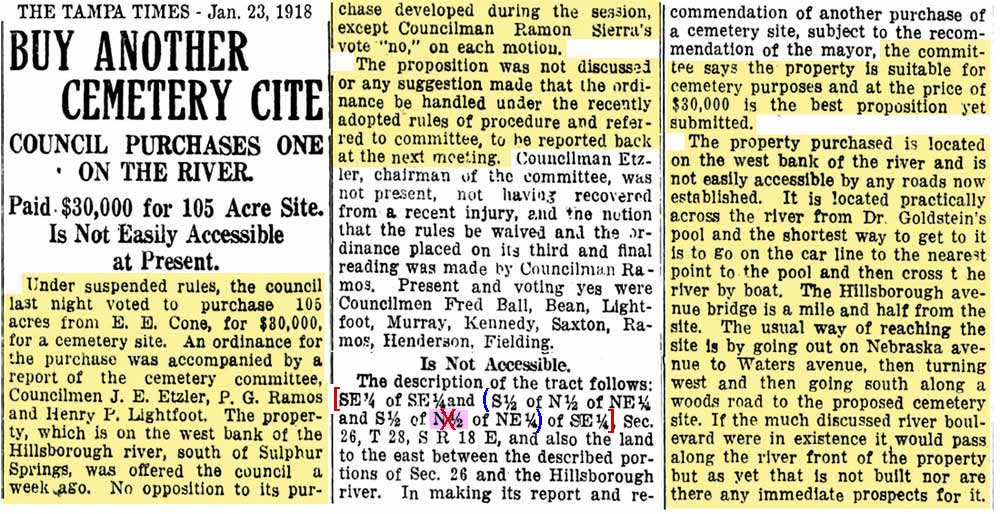
"SITE" NOT "CITE"
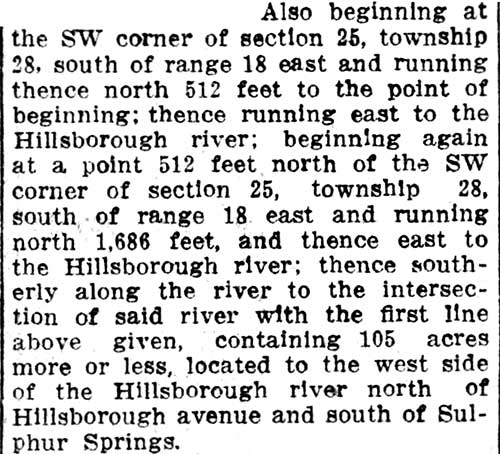 The Times' lack of punctuation causes ambiguity in the legal
description, and they include an extra measurement which causes the last
two tracts to refer to the same tract of land. By removing the
extra "N½" in the third tract ("B" on the map) and adding parentheses so
that the 2nd and 3rd tracts both refer to the SE¼ of Section 26, the
three tracts combine to form present-day Lowry Park which lies west of
North Blvd and north of Sligh Avenue. The Times' lack of punctuation causes ambiguity in the legal
description, and they include an extra measurement which causes the last
two tracts to refer to the same tract of land. By removing the
extra "N½" in the third tract ("B" on the map) and adding parentheses so
that the 2nd and 3rd tracts both refer to the SE¼ of Section 26, the
three tracts combine to form present-day Lowry Park which lies west of
North Blvd and north of Sligh Avenue.
The Tampa Tribune article
of the same day had different errors in the legal description, but gave
a more detailed description of the land in section 25, that which lies
between the river and North Blvd. today. North Blvd. is built on
the border between sections 24 and 25.
The
corrected tract descriptions are in the same order provided in
the article:
Purple square: The SE quarter of Sec. 26.
A=SE¼
of SE¼ of SEC 26, T28S, R18E.
C=S½ of N½ of NE¼ of SE¼ of SEC 26, T28S, R18E.
B=S½
of NE¼
of SE¼
of
SEC 26, T28S, R18E.
For the
land along the river bank in the adjoining Section 25, the southern boundary is 512 feet north of the
corner of today's Sligh Ave. & North Blvd., and the northern boundary is
1,686 feet north of the southern boundary.
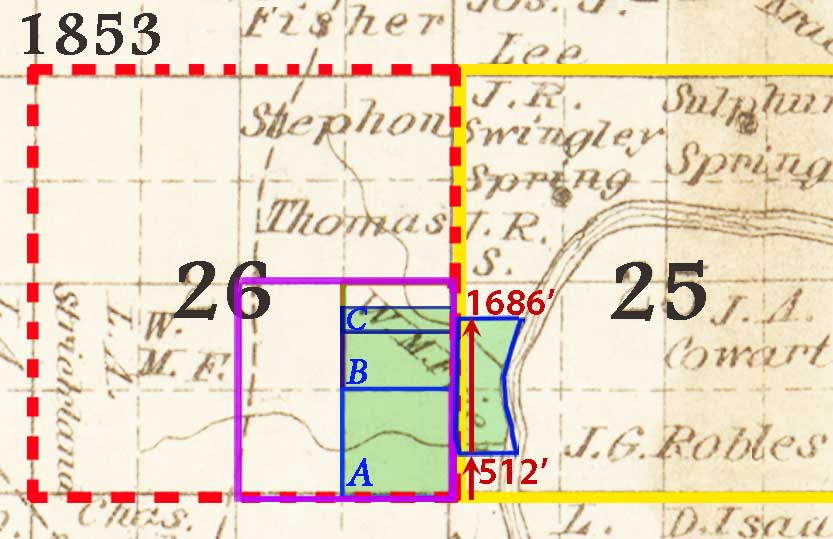
OPPOSITION
The
choice of property didn't sit well with a lot of people. Rumors that
Cone had upped the price when the City expressed interest were abundant.
On Jan. 25, the Tribune published a letter from G. Goldstein who wrote
them to say that the cemetery committee was trying to put something over
on the people of Tampa, stating that a price of less than what the City
paid had already been turned down by a previous prospective buyer. Not
only was the site inaccessible, it was considered not suited for a
cemetery, being mostly low land and wet, more suitable for truck
farming. He ends by hoping the mayor will veto this
proposition, comparing it to former foolish propositions.
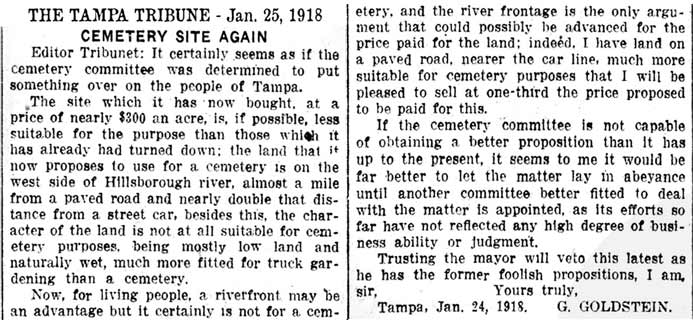
CONE ON
HIS OWN DEFENSE
The Tribune was a morning paper,
the Times was an evening paper, which worked out well for Cone. He said
after he read Goldstein's letter, he had a talk with him, and said
Goldstein was mistaken about the description of the land, and that the
flooded land
was only a small strip near the river.
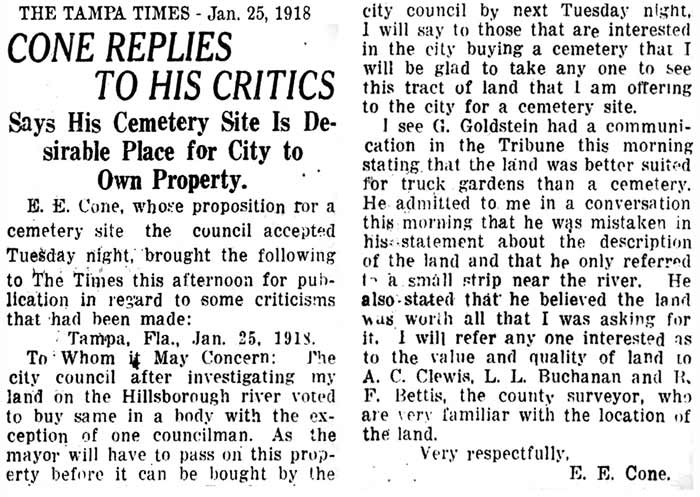
More
talk about the inaccessibility of the site was published on Jan. 26 in
the Times, with suggestions on various routes that could be improved.
There was no North Blvd. here at this time. Notice "Armina Ave." the correct original
spelling of "Armenia." The article
ends with a hope that this purchase will speed up progress on a nice new
river boulevard.
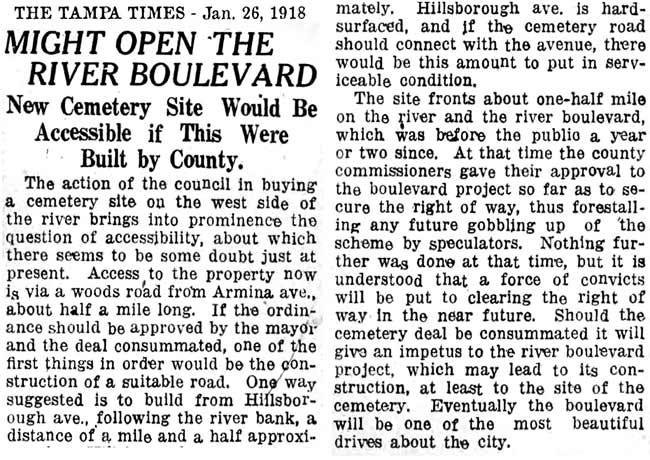
BEDINGFIELD: KEEP ME OUT OF THIS MESS
Feb.
1, 1918 - J.A. Bedingfield wrote the Tribune to set the record straight
because the mayor was told that Bedingfield had previously offered the
City his land at $100 per acre. Bedingfield says that his offer
was for 160 acres NORTH of the Cone property, and that property in the
immediate area was selling for a much higher figure. He basically closes
with what politely means "keep me out of this mess."
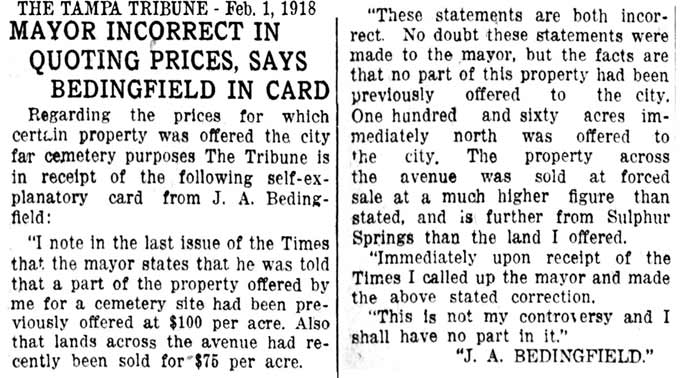
After an unsuccessful bid for the State Legislature in the previous
election, Bedingfield ran for Clerk of the Hillsborough County Criminal
Court in April 1918.
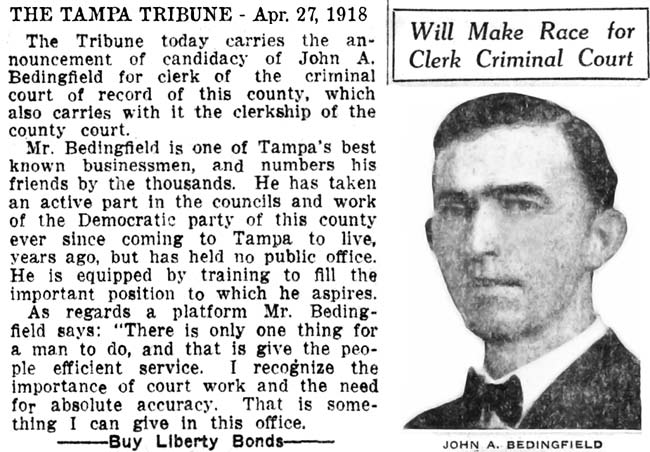
During the campaign, he was criticized by one of
his opponents, W. R. Dickenson, who questioned Bedinfield's
patriotism by stating that "no man should be elected to office
who is young enough to work in a shipyard or wear a uniform. (A
reference to WW1 in Europe.) Bedingfield responded by stating
to this point he had run his own campaign solely on merit, without
criticism of his opponents. But since Dickenson "started it"
he proceeded to pick apart Dickenson's "fake patriotism" and reveal
the patriotism of his own family, stating "those who live in glass
houses should not throw stones." He added that Dickenson
couldn't even induce his own two "handsome sons to quit their
lucrative professions and work in the shipyards."
Bedingfield's campaign expenditures of $240 surpassed not only that
of his three opponents, he surpassed all the candidates'
expenditures in the election, whose average expenditure was just
over $64. Today, $240 from 1918 would be like $5,050.
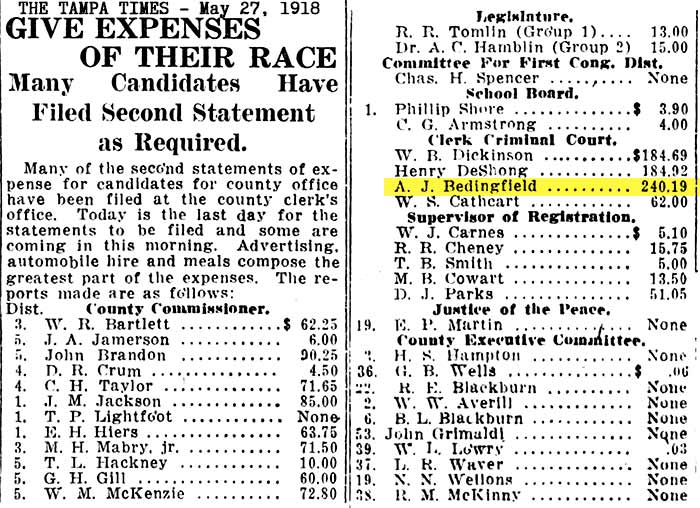 |
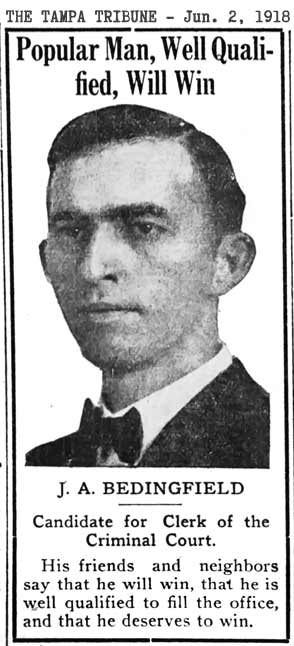 |
|

Bedingfield barely finished
second to last behind Cathcart. In elections under the
city commissioner form of government, voters made a first
and second choice for the position. The total count
was used to determine the winner. Effectively, a 2nd
choice vote carried the same weight as a 1st choice vote.
One of DeShong's campaign points was that he grew more
potatoes for the war effort than anyone else in the county. |
NEW CITY
CHARTER FOR COMMISSION GOVERNMENT ON THE BALLOT
Back during his 1916 mayoral campaign for
his third term, D . B . McKay had emphasized his opposition to the
commission form of government. He argued that the existing system
provided better representation for all sectors of the population and
that the commission form would result in limited focus of powers.
McKay was elected to a 4-year mayoral term; his 3rd consecutive term as
mayor.
With the ratification of
the 19th Amendment on August 18, 1920, giving women the right to vote,
Tampa women including Kate Jackson, Julia Norris, and Frances
Macfarlane, who had long been involved in civic affairs, mobilized in
support of a pro-commission charter.
Proponents
for the Commission-Manager system believed that this structure of
government would enable the City to conduct municipal affairs in a more
direct and business-like manner.
It took a
month for a
board of 15 selected businessmen to
carefully come up with and draft a charter they thought would be approved by the voters.
The voters approved
adoption of the commission-manager system with their vote for the new
City Charter on Oct. 19 , 1920. This new form of government,
which elected a mayor and city commissioners, appoint from among
themselves a
City Manager. The mayor essentially became a figurehead with no more
administrative power than the commissioners had. The City Manager served
as the administrative head of the municipal government.
The
Tribune, which was a huge supporter of the new charter, even used their
special red ink for the headline.
However, on the day previous to the election, they boldly predicted a 2
to 1 margin of victory.
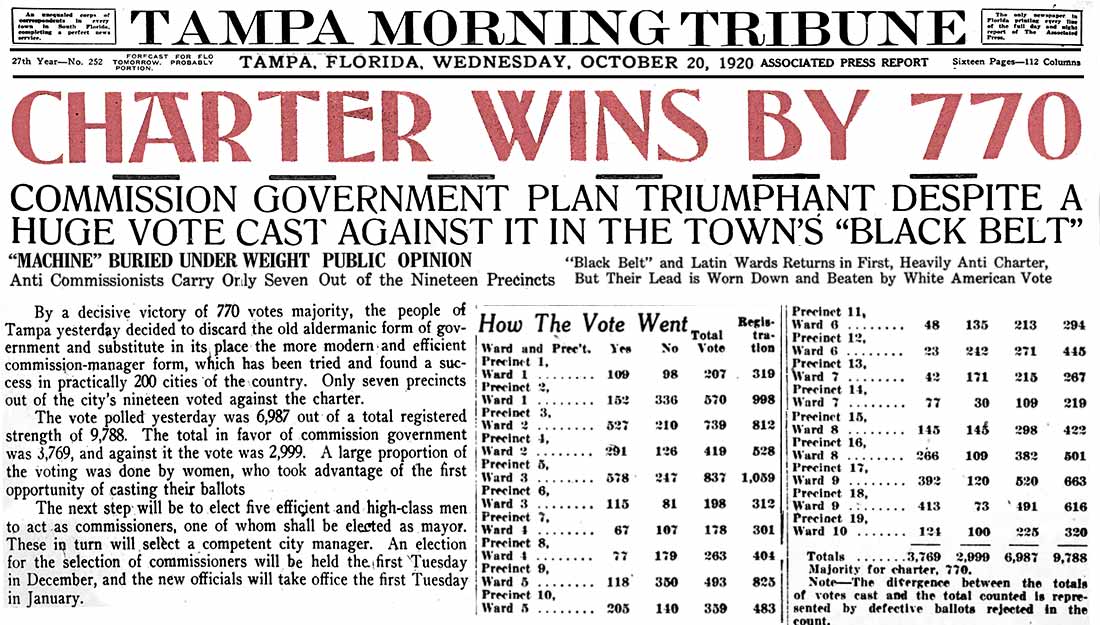 |
|
UNOPPOSED ELECTION
On Dec. 7, 1920, Tampa voters
went to the polls for the SEVENTH time, this time to vote
for the Mayor/Commissioner and how long the other four
candidates for commissioner would serve. These five
were elected in a Nov. 15 primary and ran unopposed in the
Dec. 7 election. |
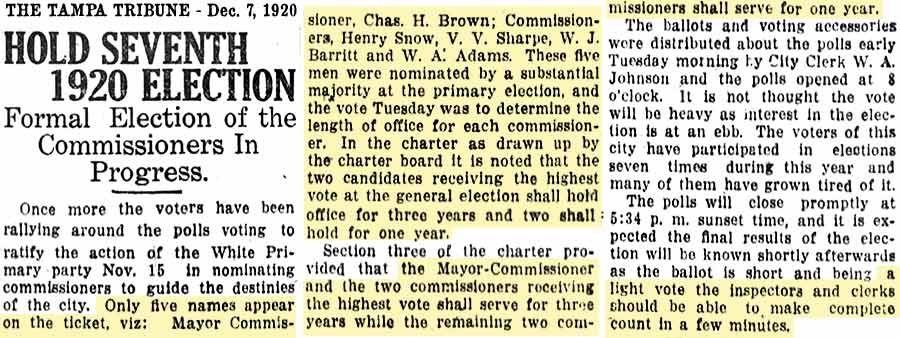 |
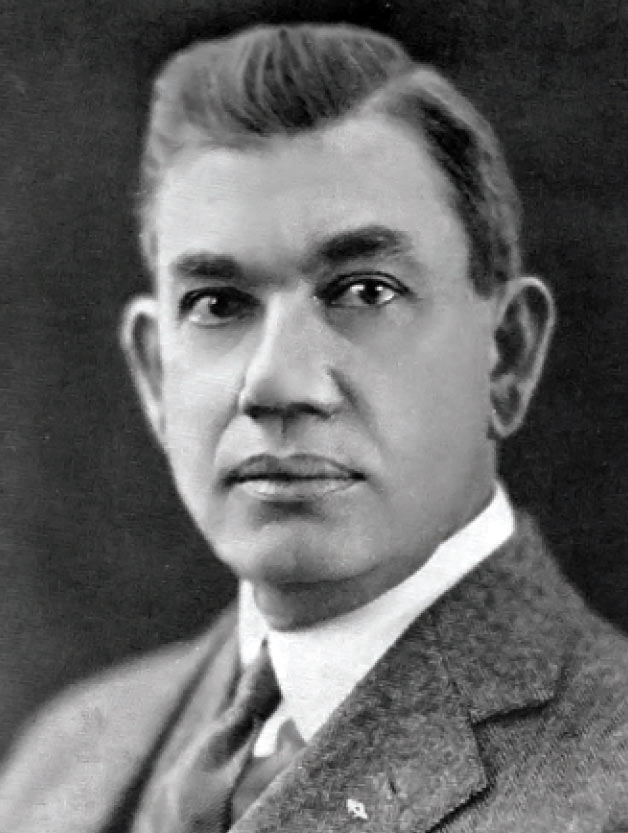 |
|
In Jan. 1921,
Charles H. Brown, the 40th mayor of Tampa, had the
distinction of being the first mayor of Tampa to serve under
the commission form of government. He served from Jan.
4, 1921 to Jan. 8, 1924.
(City
of Tampa Past Mayors - Charles H. Brown)
Perry G. Wall, having won the
next election, became the next mayor to serve under this
system of government in Jan. 1924.
Dr. Sumter Lowry, a rigorous proponent of the commissioner form of
government, was elected to a seat on the Commission in 1922.
|
Mayor Charles
H. Brown
Portrait from "Men of the South." |
|
|
CITY
COMMISSIONERS BEGIN CEMETERY SITE USAGE PLAN IN 1924 |
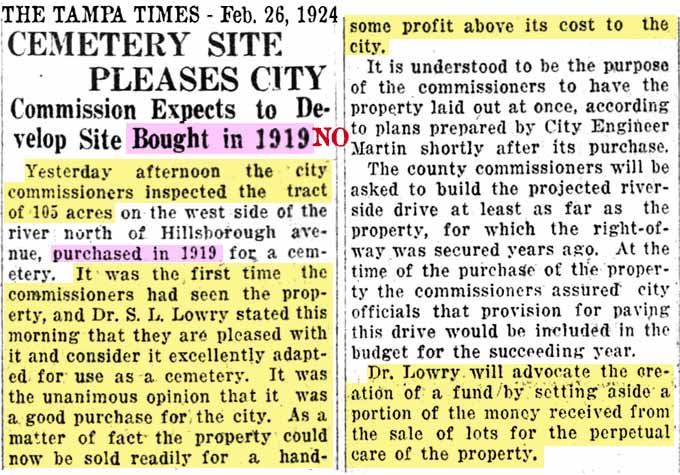
COMMISSIONERS VISIT CEMETERY SITE
In late
Feb. 1924, the
city commissioners, which included Dr. Lowry, took a trek out to see the
cemetery site for the first time. SIX YEARS had passed
since the land's purchase by the previous administration, and still
nothing had been done with the land known as the "Cemetery Site."
After
viewing the site, Lowry considered it to be "excellently adapted
for use as a cemetery" and that it had been "...a
good purchase for the City. As a matter of fact the property could
now be sold for a handsome profit above its cost to the city."
This
article incorrectly states the land was purchased in 1919.
FUNDS BUDGETED TO BEGIN DEVELOPMENT OF
CEMETERY SITE
In the summer of 1924, the "City fathers" budgeted $10k to develop the
"Riverside cemetery." Two thousand dollars was set aside to build
a combination garage/office building. Lowry was ready to hire a
competent landscape artist so lots could go on sale soon.

PRELIMINARY REPORT SAYS
LAND
BETTER SUITED FOR FISHING
The City Engineer, R. D. Martin, made a
preliminary investigation of the property and said it was better suited
for fishing. Ten acres of land was already submerged, and much of the
surrounding area suffered from water just 2 to 4 feet below ground
level. So the City Commission decided to have a soil survey done before
proceeding to beautify the landscape.
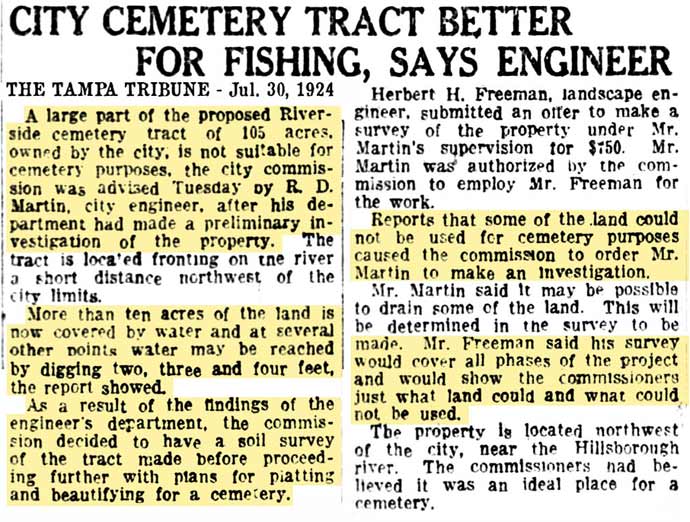
THE SURVEY SAYS...UNFIT FOR BURIALS
The next mention of the cemetery site or
soil survey thereof was printed in the Nov. 4, 1924 Times and Nov. 5
Tribune. These covered the discussions that took place on the
previous day's City Commissioners' meeting. The property is "so
poorly drained that in some portions water is found four feet under the
surface...the cemetery is unfit for burial purposes in many places."
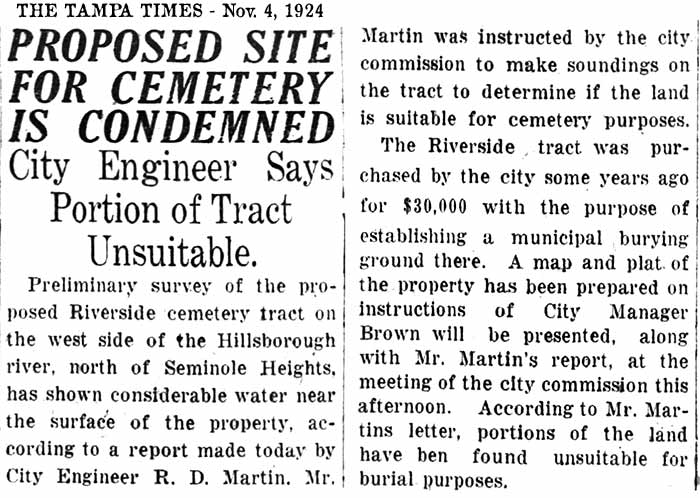 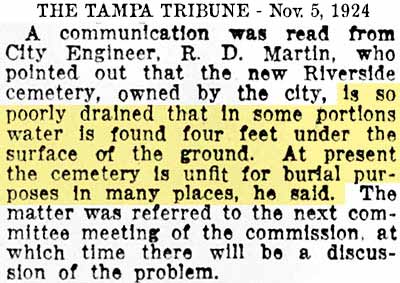
The matter was to be discussed at the next
meeting of the commissioners but no such article describing that meeting
has been found where this was discussed.
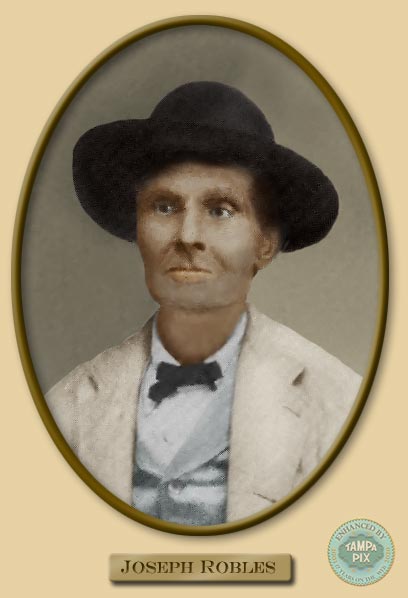
FORMER PROPERTY OF TAMPA PIONEER JOE ROBLES** CONVERTED TO
PUBLIC PARK
Seventeen acres
of land north of Floribraska Ave, between Nebraska Ave &
Florida Ave, was purchased for conversion to a public park
in early 1925 at a purchase price of $41,099.
Improvements began in late March of that year with plans to
convert Robles Pond into a lake by building a retaining
wall. The park was named Adams Park in honor of City
Commissioner W. A. Adams.
**Joseph
Robles (pronounced RŌ-bless) never had and never used
a middle name. In an era when newspapers rarely used a
person's first name and instead went by men's first two
initials and last name, in his lifetime Joseph Robles always
appears as J. Robles, Joe Robles or Joseph Robles.
Even his newspaper ads did not use a middle name or middle
initial. His obituary does not attribute a middle name or
initial.
Joseph
PAUL Robles was his son, and he wasn't a junior.
It was only in the years after Joe Robles' death that "Paul"
crept in by newspaper writers who assumed too much.
And with that, Joseph Paul Robles was turned into Joseph P.
Robles, Jr. Even Tampa historians of the mid-1900s
make the same mistake. However, Joe Robles' son,
Joseph Paul Robles, did have a son named Joseph Paul Robles,
Jr. This junior was Joe Robles' grandson.
See The Robles Family at TampaPix.com.
|
|
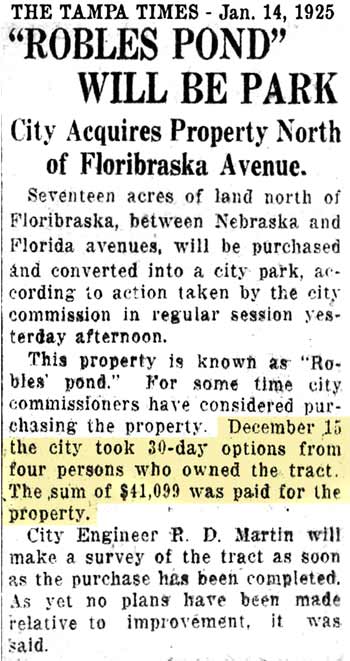 |
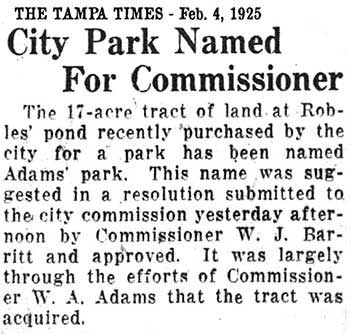 |
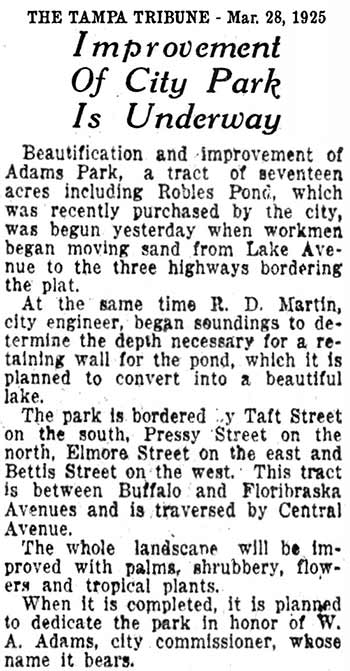 |
|
CEMETERY LAND IS TO BE USED AS PUBLIC PARK
AND NAMED
FOR SUMTER LOWRY |
|
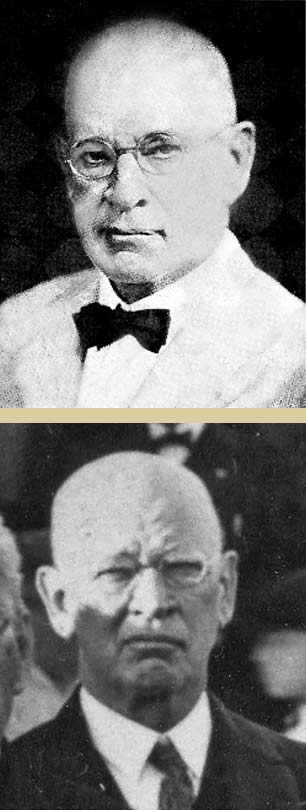
On Apr. 1, 1925, the Tribune announced that on
Mar. 31, the former cemetery site was named Lowry Park in honor of
City Commissioner Sumter L. Lowry Sr. "...consummation of arrangements for acquiring the
land for park purposes is largely due to efforts
of Commissioner S. L. Lowry."
The
term "acquiring" is misleading, because the land had already been
acquired by the city seven years earlier.
Lowry had some leading role in the process of repurposing
its use from its originally intended use as a cemetery to use as a public park.
Perhaps he was the first to propose to the commission that the land
be used as a park and proposed a preliminary plan for park use.
But none of these efforts could be found covered in news articles concerning
City Commissioner meetings from early Nov. 1924 to this point.
At the dedication announcement, Lowry was quoted as saying, "This is
the greatest honor ever conferred on me, I have done nothing to earn
it..."
Lowry may have been telling the literal truth.
|
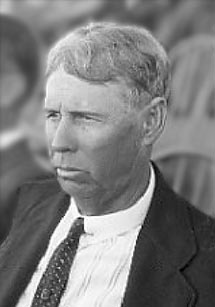 |
|
Tampa Mayor Perry G. Wall
succeeded Charles Brown in Jan. 1924 as Tampa's
2nd mayor under city commissioner government. |
|
"Therefore, be it resolved, that in
recognition of efforts put forth by Mr. Lowry to
secure for the people of Tampa and visitors a
site to be used for public park purposes, the
land above described to be
known always as Lowry Park."
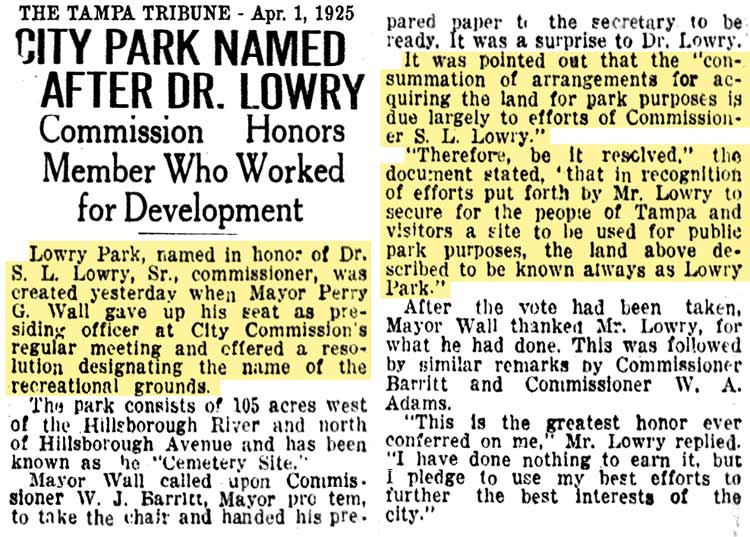
|
|
THE LOWRY MYTH DEVELOPS
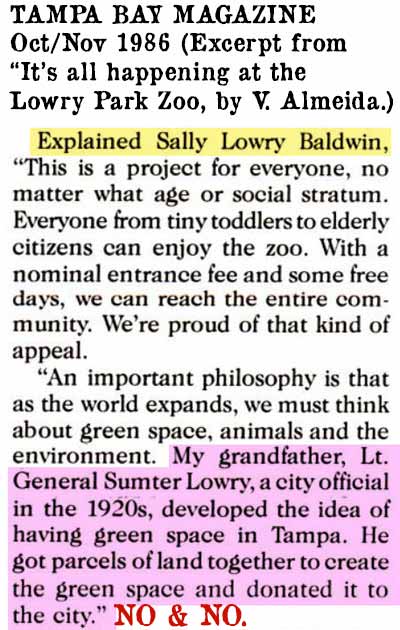 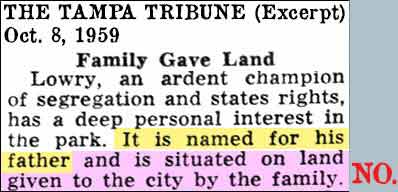 In
the years since 1925, the Lowry myth developed. By 1959, in
the midst of racial discrimination and ensuing push for integration
at Tampa's city parks, the press already thought the Lowry family
had donated the land for the park. The "ardent champion of
segregation and states rights" was describing Gen. Sumter Lowry, JR. In
the years since 1925, the Lowry myth developed. By 1959, in
the midst of racial discrimination and ensuing push for integration
at Tampa's city parks, the press already thought the Lowry family
had donated the land for the park. The "ardent champion of
segregation and states rights" was describing Gen. Sumter Lowry, JR.
In 1986, when Lowry Park Zoo was
undergoing its $20 million renovation, Tampa Bay magazine printed a
large article, a portion of which consisted of these comments by
Sally Lowry Baldwin, granddaughter of Sumter L. Lowry Jr. (the
National Guard Lt. General.)
"My
grandfather, Lt. Gen. Sumter Lowry, a city official in the
1920s, developed the idea of having green space in Tampa.
He got parcels of land together to create the green space and
donated it to the city."
Tampa Bay Magazine, Oct/Nov. 1986 at Google Books
Ms. Baldwin is evidently is confusing
her grandfather, Lt. Gen. Sumter Lowry Jr., with her
great-grandfather, City Commissioner Dr. Sumter L. Lowry (Sr.) .
Yes, he was in favor of improving Tampa's parks "in a big way, to
include golf courses and a municipal zoo, but "green space" was
nothing new to Tampa in the 1920s, they called them "parks."
Lowry Jr. was born in 1893, graduated
from Virginia Military Institute in 1914, pursued a military career
with the National Guard, saw active duty in WW1, became
a Lt. General in the 1930s and served in WW2.
He wasn't a city official in the
1920s, he was the president of the Victory Life Insurance Company.
And as you have just learned so far, it was his father, Dr. Lowry
(Sr.) who was the city official, and he didn't get "parcels of land
together," nor did he own or donate parcels of land that became
Lowry Park. It already belonged to the City in 1918 as one big
105 acre tract.
(Gen. Lowry's bio, as well as the
author V. Almeida's concept of Sheena's history, is discussed on the
breakout page "Sheena, the Baby
Elephant.")
|
|
|
|
|
|
THE
DEATH OF EBEN CONE
Ebenezer Elbert Cone,
seller of the property that became Lowry Park, died in 1927 in Ft. Myers
from an accidental shooting.
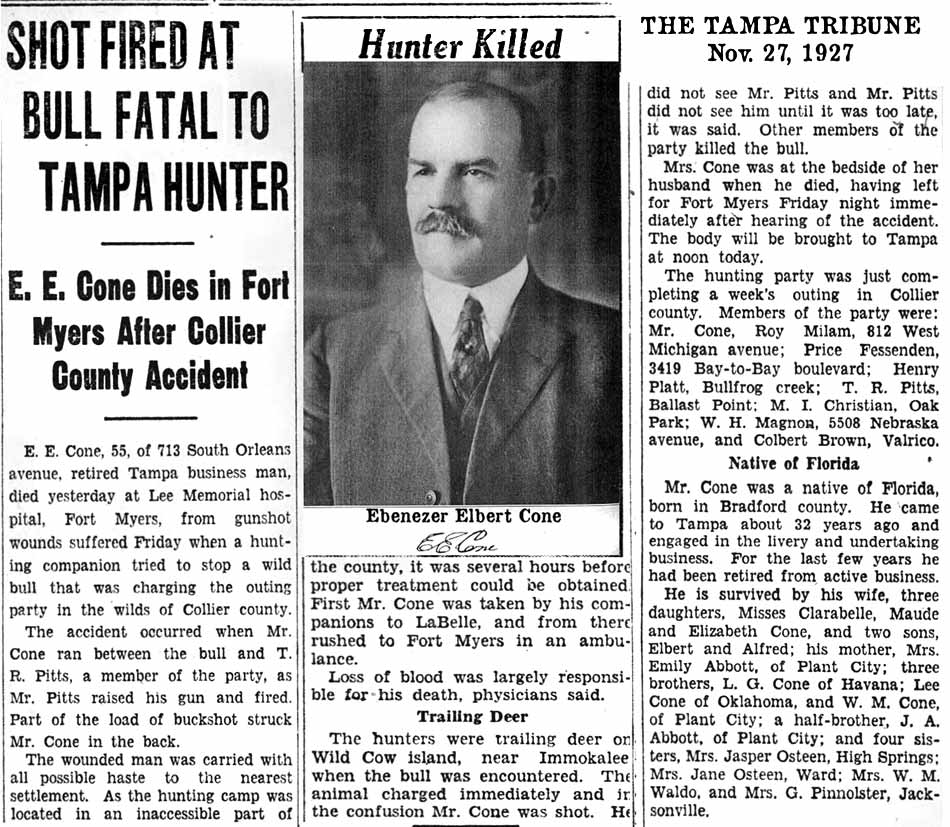
|
|
 |
|
SUMTER LOWRY RUNS FOR
RE-ELECTION
In August
1925, Dr. Lowry made his bid for re-election to the Board of City
Commissioners, entering the race for two available seats for five
candidates. Lowry laid out his platform...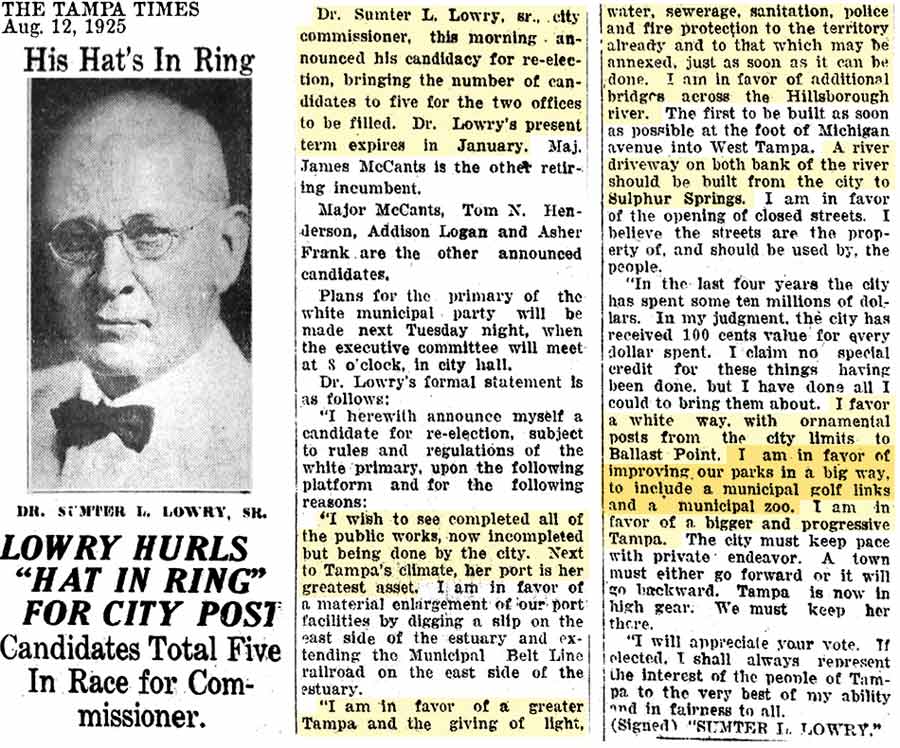
-
Finish all the incomplete public works
currently in progress in the city.
-
Provide electric light, water,
sewerage, sanitation, fire and police protection to all the areas that
had just been annexed by the city. (Ft. Brooke, West Tampa & Ybor
to name a few.)
-
More bridges across the river, starting
with one at Michigan Ave. into West Tampa (Now called Columbus
Drive) and opening closed streets.
-
He claims that the city spent "some ten
millions of dollars" in the past four years while he was city
commissioner, and every dollar was well-spent.
-
He favored a "white way" to Ballast
Point, which is what streets brightly-lit with electric lights were then
called.
-
And finally, he was in favor of
improving Tampa's parks "in a big way, to include golf courses and a
municipal zoo.
|
|
The next day, Lowry ran an ad which
included his above comments as the narrative on the left, with the list
seen below positioned in one long column on the right. It has been
rearranged into three columns to make better use of space here. He
first presents the fourteen points of his previous campaign platform,
then proceeds to show how every one of them, except for the last one,
have been accomplished are are in progress.
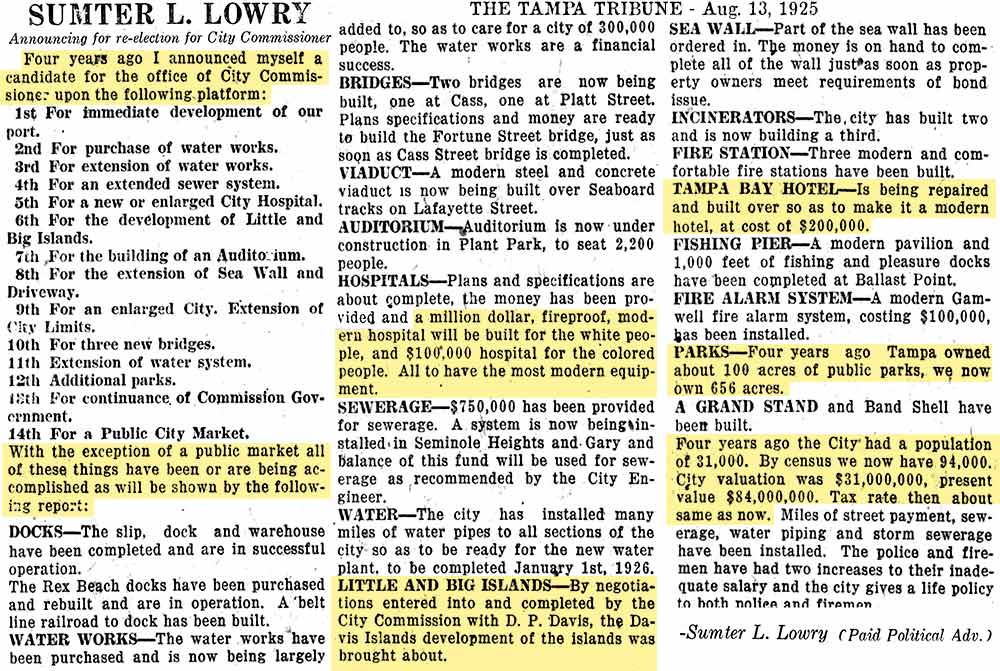
Sumter Lowry and James McCants both ran for re-election unopposed for
City Commissioner in the Nov. 3, 1925 election.
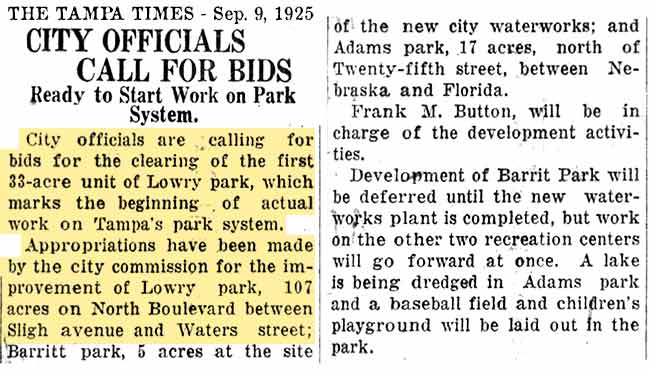
WORK STARTS ON CLEARING
LOWRY PARK LAND
The City of Tampa
advertised for bids on clearing the first 33 acres of Lowry Park,
marking the beginning of "actual work" on the park system.
City commissioners made
appropriation to improve Lowry, Barritt, and Adams parks, with Lowry
being the largest by far.
Barritt Park was located on
the Hillsborough River where the city waterworks was being built.
Adams Park was the former land of Joe Robles, where a lake was being
dredged and a playground laid out.
|
WILLIAM JAMES BARRITT |
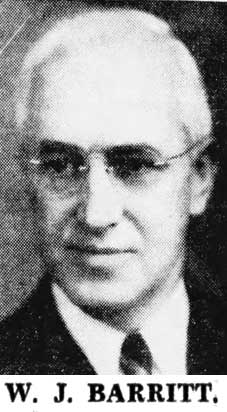
|
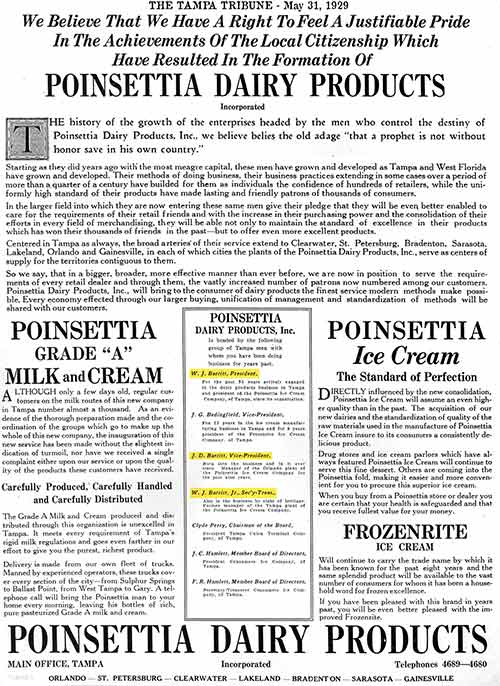 |
|
Click the ad to see it larger. |
Regarded
as the "father of the municipal waterworks," W. J. Barritt was
born in London, England in 1879 and immigrated to the United
States at a young age. His family settled in Florida in the
1880s and cultivated an orange grove near Sanford. They lost the
grove due to a harsh freeze during the winter of 1895 and they
came to Tampa soon afterward. Barritt then started a dairy
business at age 19. His success in the dairy business led
to his establishment of the Poinsettia Dairy just west of the
Tampa Bay Hotel. In 1903, it became the first distributor of
bottled milk in Tampa. Barritt began producing ice cream in
1910, and Poinsettia Dairy went on to become one of the largest
dairy companies in the state of Florida. After it was bought out
by Borden, Barritt served as Chairman of the Board of Directors
until his death. On Tampa’s City Council Barritt was on the
Appeals and Grievances Committee, the Finance Committee, and the
Police Department Committee. In 1921, when Tampa switched to a
Commission-Manager form of government, he served three
consecutive terms as Mayor-Commissioner Pro Tempore. Because of
his great efforts to establish Tampa's waterworks on the
Hillsborough River, a park was created around the facility and
named for him. He died on March 9, 1944.
Read his Mar. 10, 1944 obituary in the Tampa Times. |
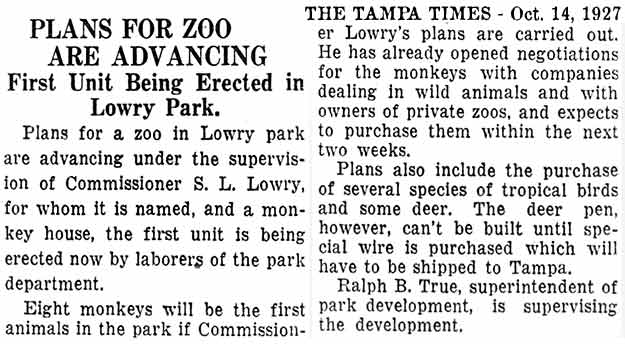
MONKEY CAGE BEING BUILT AT LOWRY PARK
Plans for a zoo at Lowry
Park were announced in mid-October 1927 with Commissioner Lowry
supervising. A house for eight monkeys was under construction and
negotiations for the monkeys were being made with companies dealing in
wild animals and owners of private zoos. The monkeys were expected
to be purchased within the next two weeks.
Plans were in place to
purchase tropical birds and deer. Supt. of Parks Ralph B. True was
supervising the development.
The Tribune had the same
basic story but included the status of the bird cage.
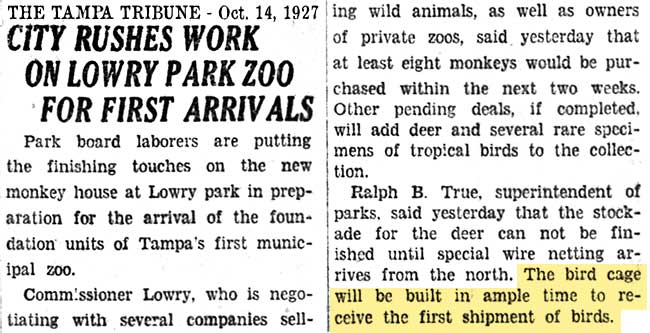
The Tribune took the
opportunity to take shots at the commissioners.


|
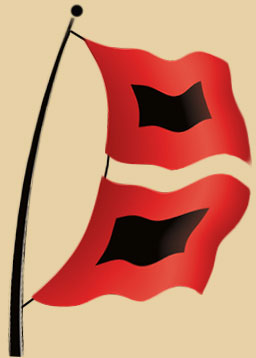
WE INTERRUPT THIS LOWRY PARK ZOO PROGRAM TO BRING YOU A
POLITICAL STORM BULLETIN
Hurricane McKay-Bartlett is headed towards Lowry Park and may make parkfall within the next 30 days. Please read this
bulletin carefully, your zoo will depend on it.
|
DECISION TIME: KEEP COMMISSION GOVERNMENT CHARTER OR GO BACK TO
MAYOR/CITY COUNCIL CHARTER
Nothing else was published about progress of the Lowry Park
zoo effort for the rest of the year 1927 as the subject in the
news turned to politics when a new city charter was to be put to
a vote on Dec. 6, 1927.
In the
current system of mayor/commissioner city government, the board
of city commissioners from Jan. 8, 1924 to Jan. 3, 1928 consisted
of: Mayor/Commissioner Perry G. Wall, Mayor pro
tempore/Commissioner William James Barritt, Commissioners
William A. Adams, Dr. Sumter Lowry, and James
McCants.

In December 1927
there was a major push to continue with this commission form of
government, under which Tampa was governed during this current
administration of Perry Wall, and his predecessor, Charles Brown. A
huge full-page ad was published in the Tribune showing all
the accomplishments of the commission form of government, and
the pitfalls of returning to a mayor/city council form of
government, urging voters to vote "NO" on the new charter.
CLICK THE AD TO SEE IT LARGER
The Tampa Times
was quick to take a shot at the
Tribune ad. The Times was owned by D. B. McKay.
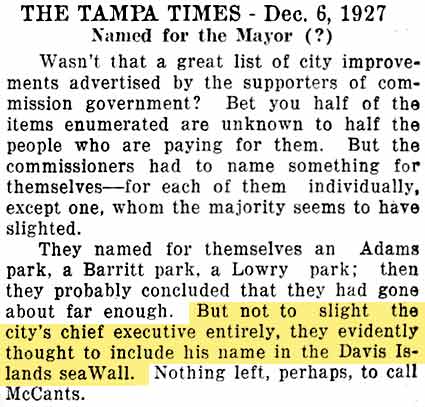
THE VOTE
THE TAMPA TRIBUNE - Dec. 7, 1927

THE TAMPA
TIMES - Dec. 7, 1927

The new charter was approved by
Tampa voters by a more than 3 to 1 margin, and the
mayor/city council system of government that was in effect
during D. B. McKay's three terms from 1910 to 1920 would return when the new charter
took effect on Jan. 25, 1928. But there was still a mayoral
election to be held on Dec. 27.
|
This article gives a
good description of the changes the new charter
would make. It also shows the vote counts for
each district.
Click the article to read it all.
|
With the new charter being voted for on the 6th, but
the election for government offices on the 27th,
just who ran for what office depended on the outcome
of the charter election.
*Once
again, "nominated" is used to mean "elected." |
|
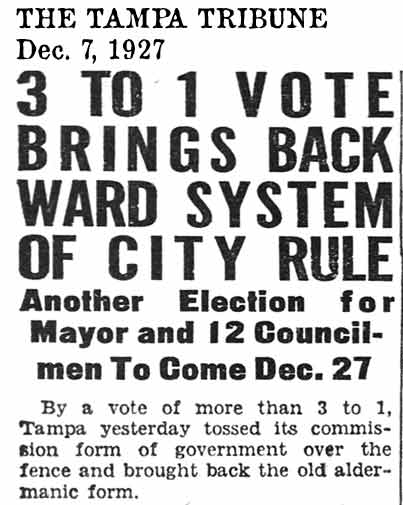 |
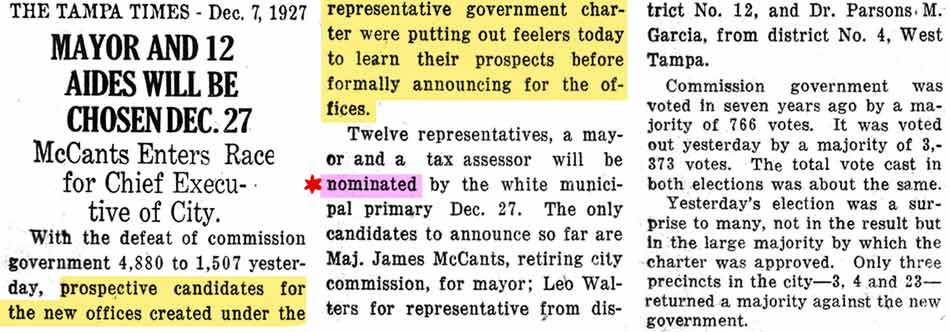 |
| |
|
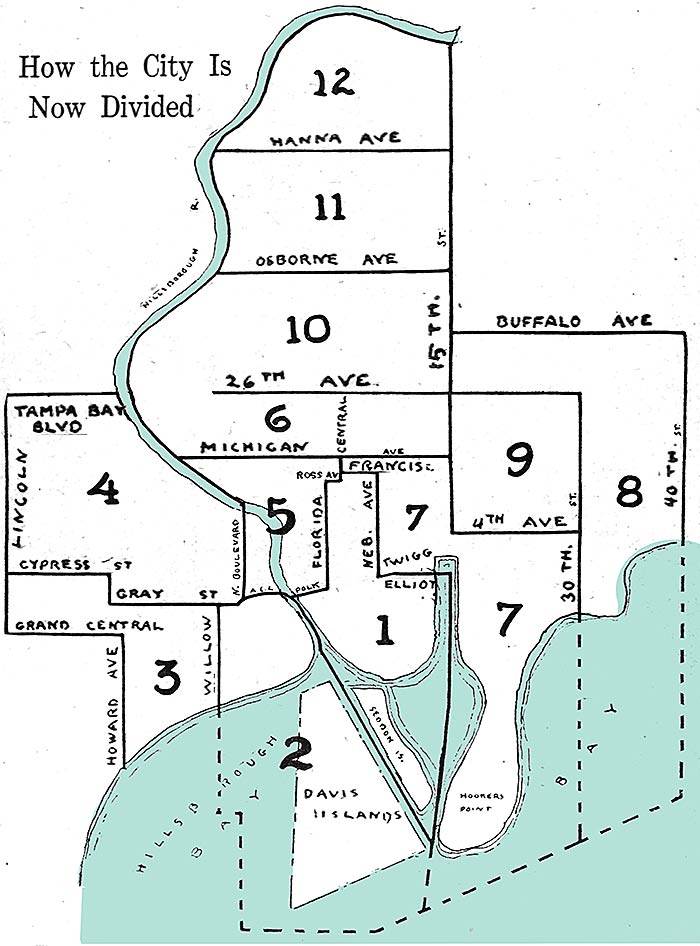
MCKAY INFURIATES COMMISSIONERS
With the passing of the new charter, the city
commissioners would be abolished on Jan. 25,
1928, and several of them were furious about
statements McKay had made during the charter
campaign, and his current campaign for mayor.
|

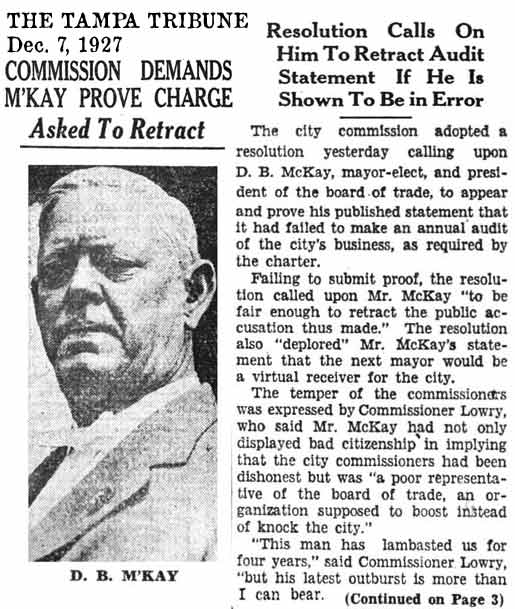
CLICK THE ARTICLE TO
READ THE REST OF IT |
It seems McKay made some
allegations that the city commissioners had failed to perform
and publish an annual audit of the city's finances for this year
as was required by the current city charter, and that Tampa was
on the verge of bankruptcy, stating that the next mayor would
virtually serve as receiver for Tampa's bankruptcy.
Commissioner Lowry was especially incensed, stating "This
man has lambasted us for four years, but his latest outburst is
more than I can bear. He should be made to put up or shut
up. Even if he believes Tampa is bankrupt, he has no right
to broadcast his views at a time when we are in the midst of
economic adjustment." He went on to compare McKay
to Moses--"We are assailed by a Moses--Mr. Moses
McKay--who promises to lead us out of the wilderness. All
right, let's have 'Moses' come before the commission and tell us
how he proposes to do it.." He went on and on to
the Tribune about it. The commissioners even passed a
resolution declaring their opinions (as facts) about McKay's
actions.
|
MCCANTS RECANTS
Current
city commissioner James McCants, who had announced his intention
to run for mayor in the Dec. 27 election, announced on Dec. 15
he did not wish to qualify. His assessment of the public
opinion was that it would have been hopeless for him to run.
And so the deadline of the 15th came and went, with McCants
intentionally failing to qualify, along with 36 other men who
had announced their intention to run. And so McKay
ran unopposed.
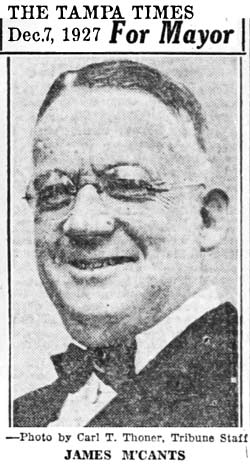 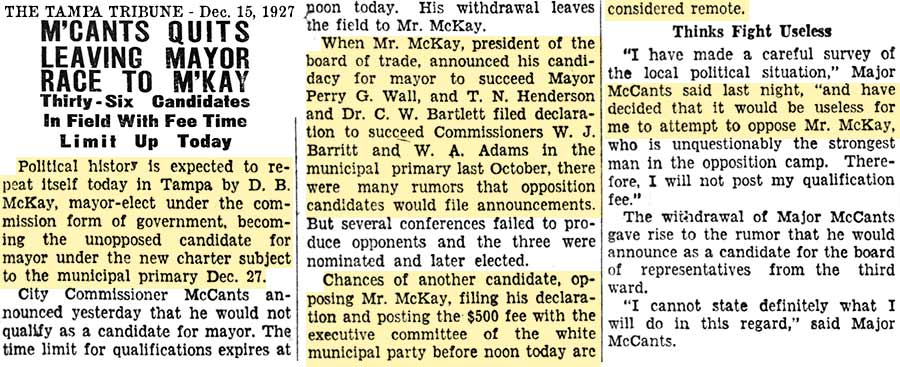 |
|
THE FINAL WEEKS OF PERRY WALL'S ADMINISTRATION - Dec. 1927
A Cemetery Site--Again.
With the end
of commissioner city government looming in the coming month,
the topic of a new city cemetery once again came to the
forefront during last month of Mayor Wall's administration.
At the upcoming city commissioner meeting, Lowry would urge
Mayor Wall to purchase a municipal cemetery, because the two
present ones, Woodlawn and Oaklawn, were completely filled,
and the only burial plots available in Tampa were privately
owned and expensive. Lowry told the Tribune, "The city
should purchase a new cemetery to lower the high cost of
dying." He spoke of a mother whose son was killed in
an auto accident, saying "she paid $250* for a piece of ground
large enough to bury her boy."
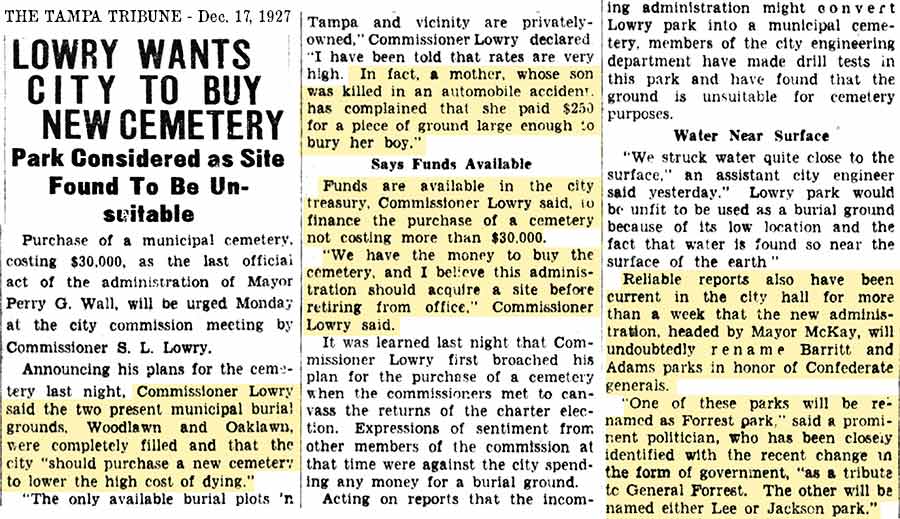
Lowry stated that funds
were available to buy a cemetery not costing more than
$30,000**. Lowry approached the commissioners back
when the new charter was passed in early December, and at that time the others
were against the purchase. Lowry now was acting on
reports that the incoming administration might try to
convert Lowry park into a municipal cemetery, even though
drill tests showed the ground was saturated and unsuitable
for burial.
*Two hundred
and fifty dollars in 1927 would be like $3,806 to us today.
**Thirty thousand dollars in 1927 would be like $456,684 to
us today.
(U.S. Inflation Calculator.)
RUMORS OF PARKS TO BE RENAMED BY MCKAY ADMINISTRATION
There were
also "reliable reports current in city hall for more than a
week that the new administration, headed by Mayor McKay,
will undoubtedly rename Barritt and Adams parks in honor of
Confederate generals and that one would be named Forrest
park, as a tribute to General Forrest, and the other will be
either Lee or Jackson park.
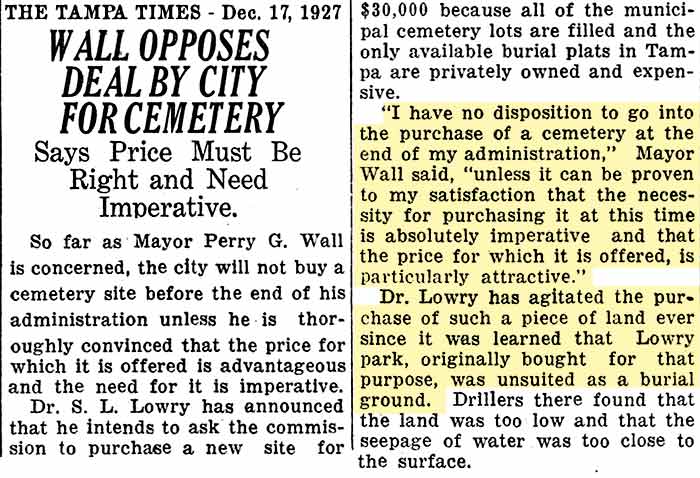 Mayor Perry
Wall's response to Lowry's suggestion was printed on Dec. 17
in the Tampa Times. Wall's stance was that the city
would not buy a cemetery site before the end of his
administration . "I have no disposition to go into the
purchase of a cemetery at the end of my administration,
unless it can be proven to my satisfaction that the
necessity for purchasing it at this time is absolutely
imperative and that the price for which it is offered is
particularly attractive." The article ends with the
Tribune saying "Dr. Lowry has agitated the purchase of a
piece of land ever since it was learned that Lowry park,
originally bought for that purpose, was unsuited as a burial
ground...the land was too low and seepage of water was too
close to the surface." Mayor Perry
Wall's response to Lowry's suggestion was printed on Dec. 17
in the Tampa Times. Wall's stance was that the city
would not buy a cemetery site before the end of his
administration . "I have no disposition to go into the
purchase of a cemetery at the end of my administration,
unless it can be proven to my satisfaction that the
necessity for purchasing it at this time is absolutely
imperative and that the price for which it is offered is
particularly attractive." The article ends with the
Tribune saying "Dr. Lowry has agitated the purchase of a
piece of land ever since it was learned that Lowry park,
originally bought for that purpose, was unsuited as a burial
ground...the land was too low and seepage of water was too
close to the surface."
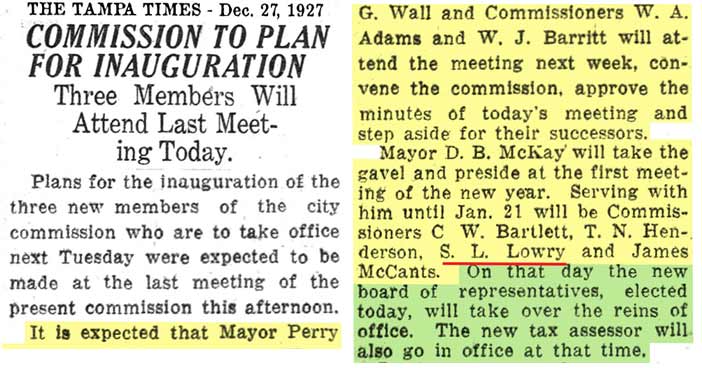
SHORT TERM
COMMISSIONERS
Of the
"lame-duck" city commissioners, two of the
five stayed on to the bitter end--Jan. 24, 1928, as the new
charter would take effect the next day when twelve elected city
councilmen (or representatives as they were called) would take
their seats. So on Jan. 3, 1928, with the city
still under commissioner form of government, commissioners
McCants and Lowry stayed on, and were joined by the
new administration of D. B. McKay as Mayor/Commissioner,
T. N Henderson (Mayor Commissioner pro tempore,), and Dr.
C. W. Bartlett. |
|
ON JANUARY
25, 1928, THIS BOARD OF REPRESENTATIVES WOULD TAKE OVER, WITH
MCKAY AS MAYOR
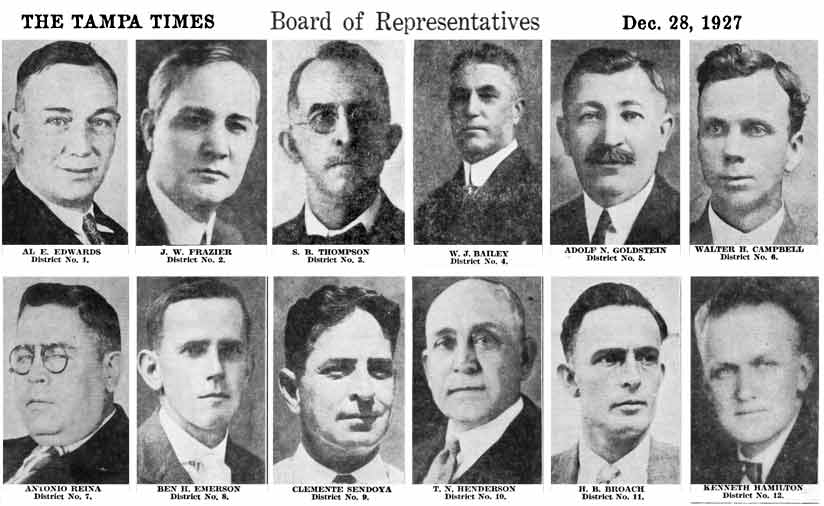 
THE TAMPA TRIBUNE CALLS FOR END TO
HOSTILITIES
The
Tribune printed a fair and honest account of what had
transpired, stating "The Tribune bespeaks for the new regime the
fullest opportunity to justify itself, without captious
criticism or factional ill-feeling or resentment....If it does
not prove satisfactory, the people will have the same right to
abolish it that they had to abolish the commission form.
After months of agitation, unrest and hostility, "let's have an
end of disturbance , and all get together for a year of
constructive work for the advancement and prosperity of Tampa."
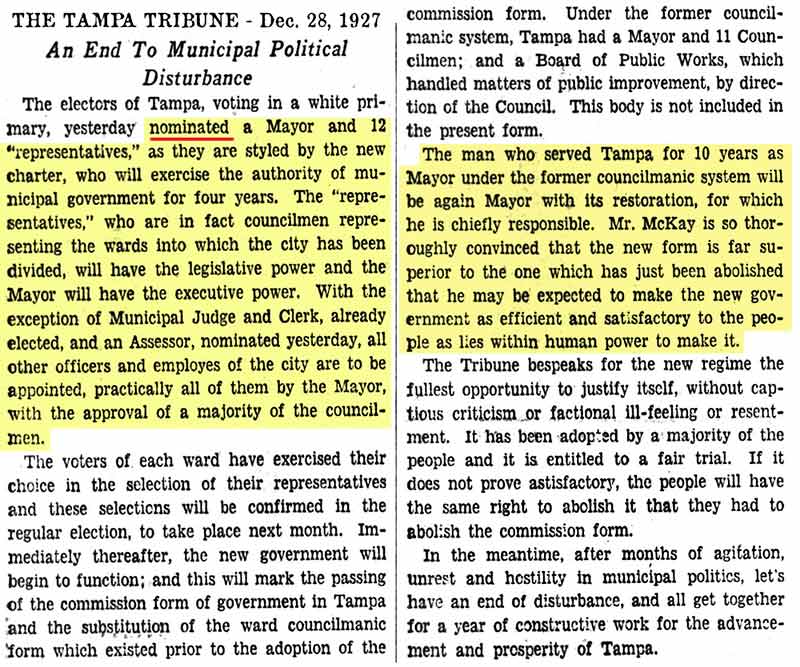
Rumors
persisted that Lowry Park, Barritt Park, and Adams Park would be
renamed for Confederate generals, or one of them for McKay.
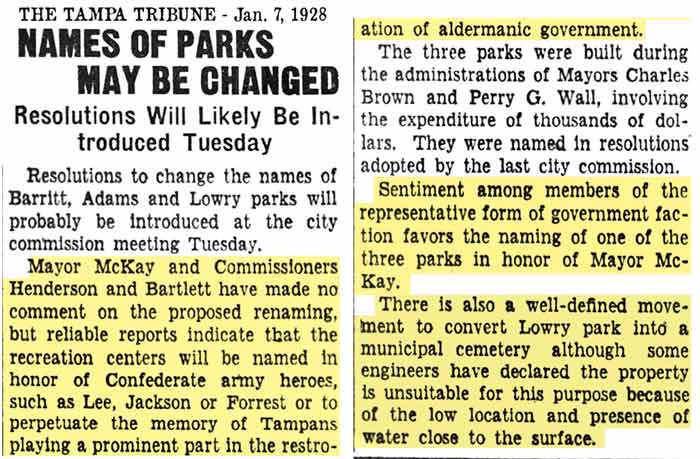
|
 |
 |
HURRICANE MCKAY-BARTLETT
HITS LOWRY PARK
|
The
temporary City Commissioners (in effect Jan. 3 through
Jan. 24) consisting of holdovers Lowry and McCants, with
the three new ones T.N. Henderson, C. W. Bartlett, and
D. B. McKay as Mayor/Commissioner, met on Jan. 10
to review bills that Lowry had submitted for zoo-related
purchases on December 31, 1927. He had turned them
in to the new city manager for payment who in turn
questioned the legality of his purchases so turned them
over to the commissioners for review.
One issue
at hand was whether Lowry had the authority to make
these purchases without any knowledge or involvement by
the Board of Parks, which was supposed to recommend and
make the purchases according to lowest bid.
Another
issue was that any purchase over $300 must be put up for
bids to determine the vendor. Lowry had separate
individual invoices for animals and materials for the
zoo, each invoice $300 or less. Some were multiple
invoices from the same seller. They were clearly
broken up in separate invoices to avoid having to go
through a bidding process for the animals.
Commissioner Bartlett snapped back at Lowry with "If we
followed such a precedent as that we could have financed
the city hospital in $300 batches!"
Another
issue was that the purchases showed the approval of then
City Manager Lesley Brown on his last day in office.
Was the City legally bound to pay the bills, to keep
what had already been delivered, and forced to accept
what had not yet been delivered? All this
was a matter that would be left to City Attorney Karl
Whitaker.
No doubt
McKay had in mind the resolution passed by the previous
board of commissioners rebuking McKay's actions during
the campaign, as well as Lowry's bold statements about
him such as calling him "Moses McKay" and "This man has
lambasted us for four years" and "it's time for him to put up or shut up." |

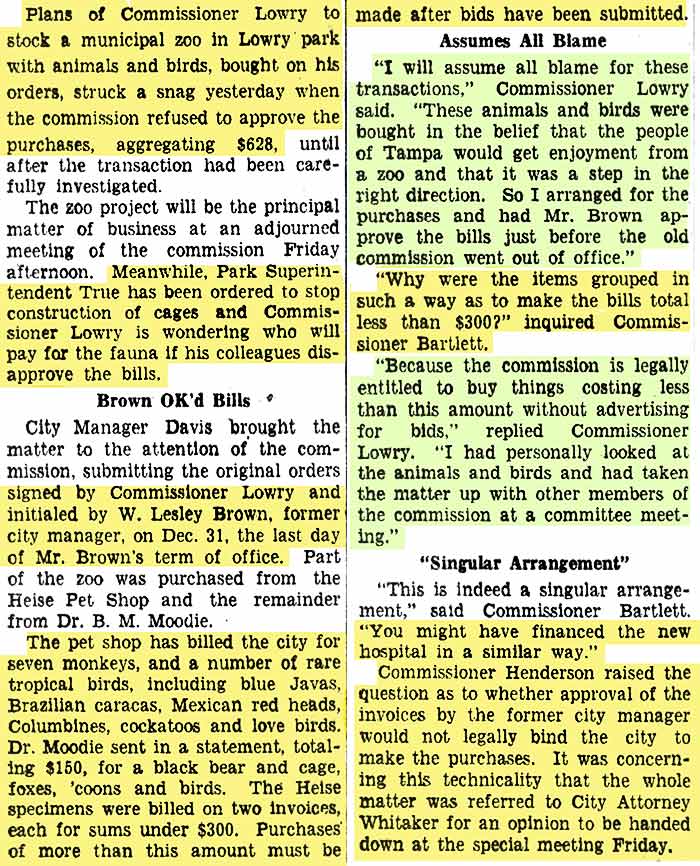
In
1928, $628 was like $9,727 to us today.
Purchases were made from a pet shop on
the same day totaling $478 but they were
divided into two invoices, one for
$287.50 and the other for $190. |
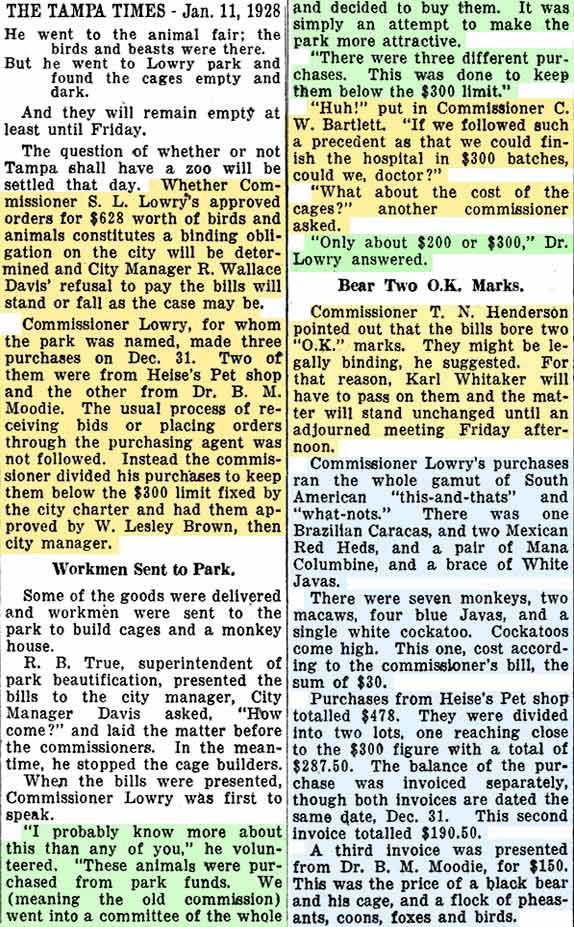 |
|
|
|
|
COMMISSIONER LOWRY RAKED OVER THE COALS FOR
PURCHASES
Upon the
recommendation of city attorney Karl Whitaker, the
city commission decided to not pay the bills Lowry
had turned in for payment. Whitaker's opinion was that the
purchases had not been authorized properly by the old
commission, the park board or the purchasing
department.
Commissioner Bartlett
was the most aggressive of those at the meeting,
with him and Lowry clashing a time or two. McKay ran a
close 2nd. Lowry said he thought that the park board
approved of the buying of the animals, "....and
if you go ahead and tear up this zoo just to
discredit the old commission, than I'll have nothing
to say. I was just carrying out one of the
policies of the commission. We always did
that." But later he says the park
board has never met. He said Mr. Adams and Mr.
Barritt both had charge of beautifying their parks.
"What I did was done in good faith. I
didn't think I had exceeded my authority. I
knew I could not purchase more than $300 without
bids, but it has always been a policy for each
commissioner to look after his own park."
At this point, McKay asked "Is this a matter of
record. Is it in the minutes?" Lowry
said "I don't know."
Bartlett began his
attack by asking if they had a park board, which he
already knew the answer was yes, but clearly wanted
to catch Lowry in a trap. He then asked Lowry, "What
is it for?" Lowry answered "To
beautify the parks, I suppose. But I don't
think it has ever had a meeting."
Bartlett said he wasn't against having a zoo, but
questioned if the city had a right to get one this
way. He told Lowry "Well, you exceeded your
authority, it was the park board that should have
decided to buy the animals." Bartlett
claimed that if he followed the same logic of buying
in under $300 purchases, he could have bought the
police chief a Cadillac, one part at a time.
LOWRY IN GREEN,
MCKAY IN PINK,
ALL OTHERS IN YELLOW. |
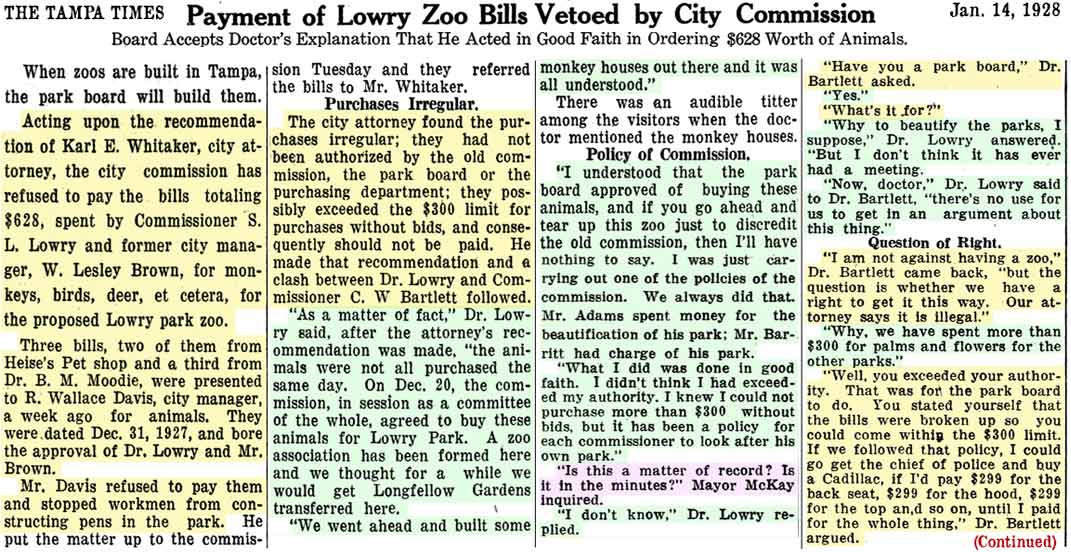 |
|
READ THE REST OF THIS ARTICLE (When it
opens, click it again to zoom in.)
In the continuation of
this article, among other statements, Lowry says "Well
it's too small a matter for me to argue, it is
simply what this commission has been doing for the
past seven years. The city manager has made
many purchases of this sort. Whitaker
answered "But the city manager had no such
authority." Lowry then said "Anyway,
that's the way we did it and that's what you will
do, too."
This last statement by
Lowry seemed to anger Mayor McKay, who jumped in
stating "If I can prevent it, this commission
will do NO SUCH THING. I'm not opposed to
having a zoo, but I believe this is an irregular
proposition. No authority is shown in the
minutes, and this letter you have from the committee
of the whole says nothing about this proposition.
What we're trying to do is determine the proper
thing to do...I am going to insist that every
transaction of this commission be regular."
|
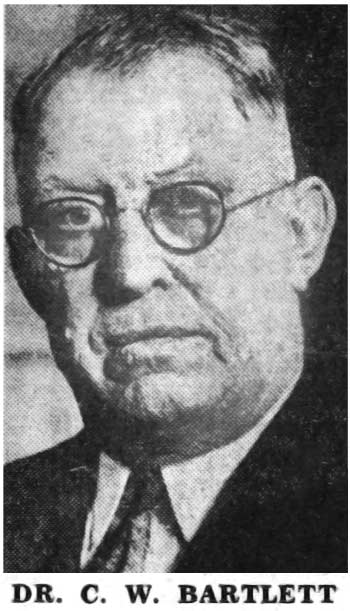 |
DR.
CHARLES W. BARTLETT
Dr. Charles William
Bartlett died of a second heart attack on May 28,
1929 at his home in Tampa; he was 59. Bartlett was
born in1870 on his grandfather’s plantation in Sagua
la Grande, Cuba. His father had gone there to
manage the plantation. Charles studied medicine at
the University of Maryland and received his M.D. in
1893. In 1895, he moved to Tampa and opened a
medical practice. He served on the Florida State
Board of Health representing Hillsborough County and
also became the Assistant Health Officer of South
Florida. His son, Dr. Charles William Bartlett, Jr.,
followed in his footsteps and became Tampa’s City
Physician.
|
|
Read his May 30, 1929
obituary in the Tampa
Tribune.
Some info from "Tampa's
City Council and Centennial
Celebration of Old City Hall"
(Don't believe everything
you read in it about old
City Hall, especially about
the clock, "Hortense."
Get the truth
here at Tampapix.) |
Commissioners McCants
and Henderson were more sympathetic, with McCants
stating that Dr. Lowry had been punished enough by
what the other commissioners had said, in view of
the policy of the old commission. Henderson
said, "I don't want to put myself in the position
of trying to embarrass the men who were on the
commission. If the commissioners and the city
manager knew about it, I believe it was done in good
faith."
McKay got in one more
punch, "Did you ever ask your attorney for an
opinion?" Lowry said "No, I guess not."
Henderson asked the
others to accept Dr. Lowry's explanation, and said "Let's
not do any spite work. If the thing was wrong,
let's take Dr. Lowry's word that he acted in good
faith."
With that, a motion
was made to approve Whitaker's opinion and not pay
the bills, to accept Lowry's explanation, and to
convey the matter to City Manager Davis to take up
the matter with the park board.
"And that ended the
"fight" for the monkeys."
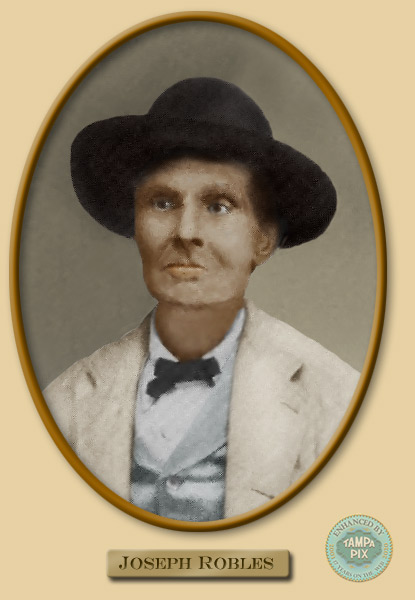 ADAMS PARK RENAMED JOSEPH ROBLES PARK
- Feb. 14,* 1928 ADAMS PARK RENAMED JOSEPH ROBLES PARK
- Feb. 14,* 1928
With a 10 to 2 vote,
the city board of representatives changed the name
of Adams Park to Joseph Robles Park, "in honor of
one of the city's pioneers and father of Circuit
Judge Francis Marion Robles." (The land was
originally the homestead of Joseph Robles.)
The park was originally named for City Commissioner W. A.
Adams who was a member of the board during the
previous administration (of Mayor Perry Wall.)
The Tribune took this action to mean that the two
other parks would be renamed, but they never were.
Strongly against the renaming was Rep. Campbell, not
that he had anything against Robles, but because he
was vehemently against naming ANYTHING for men.
He claimed it would be more fitting to build a
monument to Robles, stating "I am sick and tired and
fed up in naming anything for citizens." Rep.
Frazier said the move was no reflection on Adams'
character or reputation, but rather the announcement
of a policy opposed to naming public improvements
after living citizens. He further stated that
the Federal and State governments use the same
policy. Campbell closed with "What assurance
do we have that the park will not be renamed in four
years when another administration comes into power?"
But the question was not answered and the resolution
was adopted.
*Feb. 14, 1847 was the
birthday of Joe Robles' son, Joseph Paul Robles.
Joseph P. Robles was NOT a "Jr." because his father
had no middle name.
Read about the life of Joseph Robles and his family,
along with information about his land patents,
here at TampaPix.
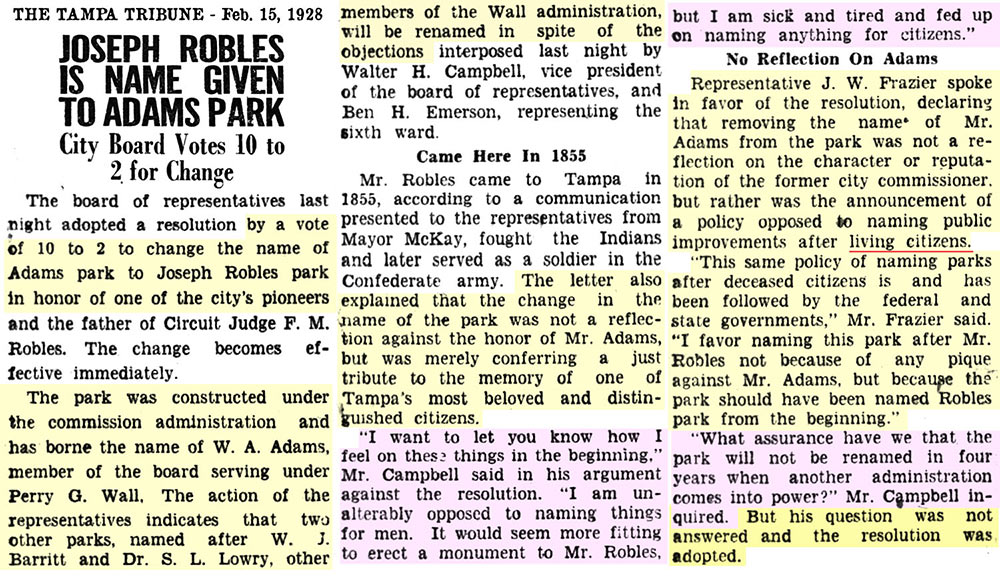
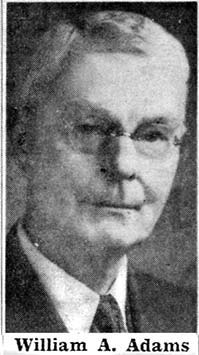 |
WILLIAM ANDREW ADAMS
Born in
Georgia on February 13,
1871, William A. Adams
worked on his family’s farm
before coming to Tampa in
the 1890s. He became a
bookkeeper for the Tampa
Lumber Company and later
purchased the Tampa Grocery
Company. Adams would go on
to establish his own
wholesale grocery and he
enjoyed much success in this
venture. He served three
consecutive terms as a
Commissioner during the
seven years that the City of
Tampa had a
Commission-Manager form of
government and many public
improvements were made
during this time. Adams
served as a steward in the
First Methodist Church for
more than fifty years. He
died in Tampa on December
22, 1950.
Read his Dec. 23, 1950
obituary in the Tampa
Tribune.
Info from "Tampa's
City Council and Centennial
Celebration of Old City Hall"
|
| |
|
The 1931
Sanborn Map below had not changed
the name to Robles Park.
Map
courtesy of the University of
Florida Library digital map
collection.
Mouse-over the map to see it change
to present-day view.
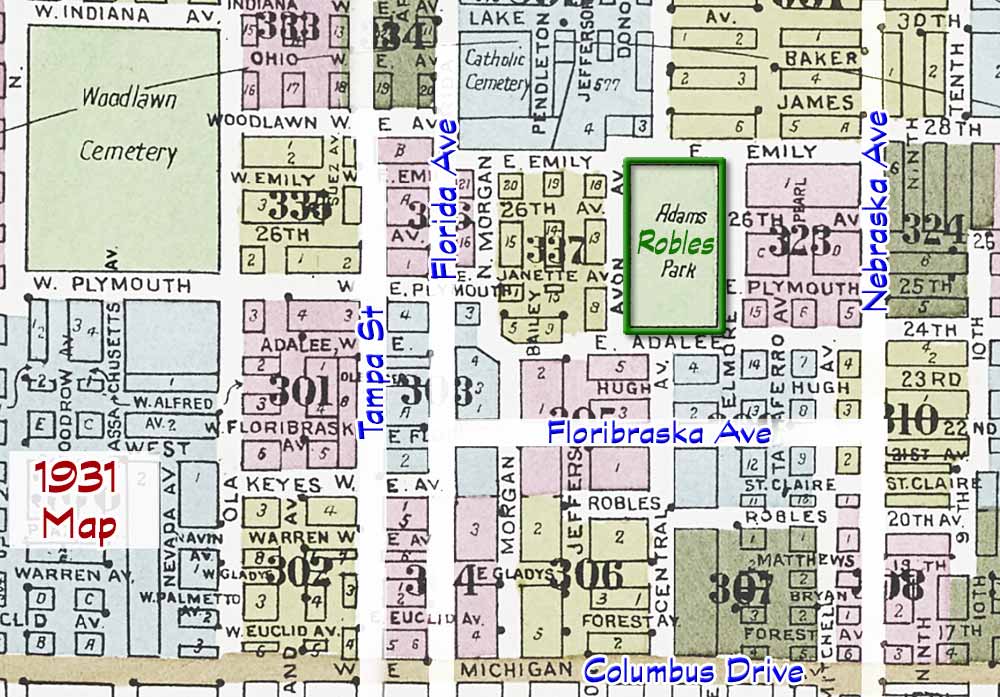
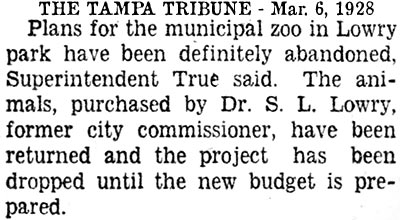
WE WOULD RETURN YOU TO OUR
REGULAR LOWRY PARK ZOO PROGRAM, BUT IT'S OVER. FINISHED.
By Mar. 6, 1928, the animals had all
been returned. The project was
"dropped until the new budget is
prepared." (Which would be in
about 30 years.)
|
|
|
LOWRY PARK BEFORE
FAIRYLAND - THE FEDERAL EMERGENCY RELIEF ADMINISTRATION
So the story continues,
"In the beginning, Lowry Park was
little more than 105 or so acres of picnic grounds. Well, there was
actually more to it than just that.
THE FERA
TRANSIENT RELIEF CAMP
In Jan. 1934,
work began on on building a Federal Emergency Relief camp on the
grounds. The
Federal Emergency Relief
Administration (FERA) was the new name given by the Roosevelt
Administration to the Emergency Relief Administration (ERA) which
President Roosevelt had created in 1933. Under Roosevelt, the
agency gave loans to the states to operate relief programs during the
Great Depression.
Group of FERA cabanas on the grounds of Lowry Park, north of Sligh Avenue in April,
1935.
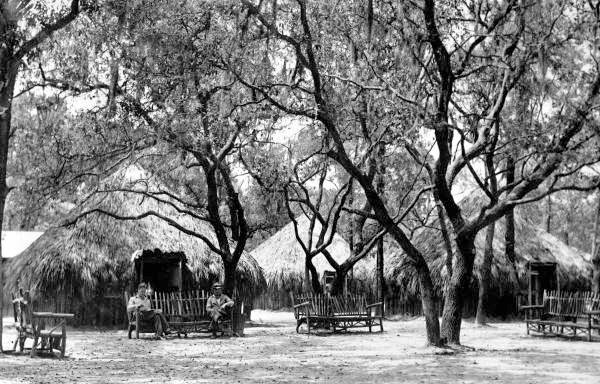
Photos from Florida Memory at Florida State Archives.
The cabanas were part of FERA project 29-B4-255, a part of the
Lowry Park Transient Camp.
The camp turned out to be a very
well-operated facility, with the residents becoming another responsible
Tampa community. There were eating facilities, a staff doctor, and
plenty of room for sports. They participated in area sports, with
their own baseball team, boxing team, track team, and entertainment
events put on by the residents at the camp and around town, and given
for the residents by the Tampa community as well. In fact, the
news about the camp in 1934 and 1935 was heavily dominated by articles
and scores for the results of their baseball team league games,
boxing matches, and entertainments they gave and received.
By summer of 1936 Federal funding was cut
and the camp residents began to diminish. It was closed in August
1936 with a possible plan by the Federal government to fund development
of Lowry Park, which fell through due to limited funds.
But Tampa
had a "Plan B" and the facility was developed into something else for
those in need. |
|
READ MORE ABOUT THE CAMP AT LOWRY PARK -- IT LASTED ALMOST TWO YEARS
This breakout page also features the
construction of Middleton High School, another FERA project in Tampa.
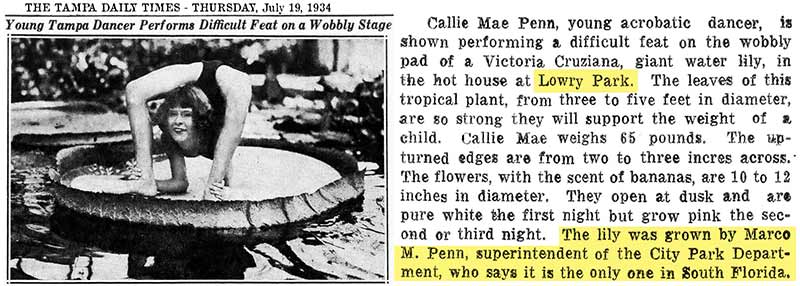
|
|
| |
|
TAMPA'S
CITY ZOO AT PLANT PARK
SO THE STORY GOES...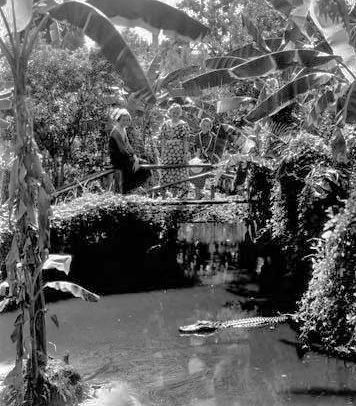
Tampa's zoo began around 1937 as an animal shelter in Plant Park, on the banks of the Hillsborough River near downtown.
It was started by city employees and originally consisted of a small collection of indigenous animals such as raccoons,
alligators and an aviary with a variety of exotic birds.
Three women looking at
alligator from a foot bridge in Plant Park, Sept. 11, 1936.
Burgert Bros. photo from the Tampa-Hillsborough County
Public Library digital collection
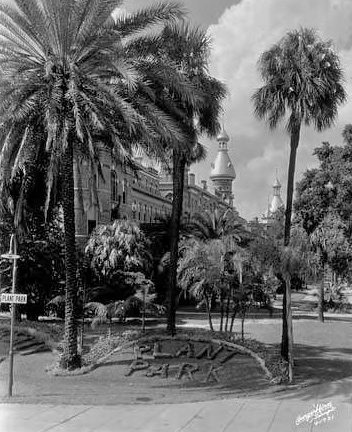
The entrance to Plant Park
with the University of Tampa in the background, Sept. 5, 1936.
Burgert Bros. photo from the Tampa-Hillsborough County
Public Library digital collection.
|
HOW
AND WHEN THE "TAMPA CITY ZOO" AT PLANT PARK STARTED AND ENDED
The nucleus of what
would become referred to as the "Tampa City Zoo" or "Plant Park Zoo" was
actually started before 1937 and it was started by ONE city employee.
Throughout Plant Park's approximately fifteen to twenty year
history, alligators and bears would be the main attraction, as
various ones came and went, escaped, or died. There were
also in the early years, some "exotic" or non-indigenous animals,
some from Mexico,
which helped to attract even the Florida natives to the park.
As for
this often repeated story...
"As the zoo collection at Plant Park had grown, the animals were moved during the term of Mayor Nick Nuccio to the more centrally located
Lowry park in
1957 where it was maintained by Tampa's Parks
Department."
... you
will see what really happened, and it was not the
story above.
PRIVATE ZOOS
There were
also quite a few private (or "back yard") zoos in Tampa and the
surrounding area by the early 1900s. The most
well-known ones were at Sulphur Springs and at a Sunoco filling station. Sulphur Springs was mainly a
reptile farm, and the Sunoco station zoo in particular was a
very popular hangout,
with thousands of visitors a year.
It
had a much larger, more diversified collection of animals than
Plant Park's, and its owner, Albert Boyd, knew how to advertise them to draw
in the crowds. It was the most popular zoo in Tampa before
Fairyland Zoo at Lowry Park.
Learn about
these zoos at:
TAMPA'S FIRST ZOOS |
|
|
|
LOWRY PARK BEFORE FAIRYLAND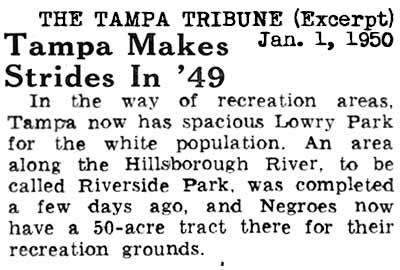
On Jan. 1, 1950, in a very
long article, the Tribune recounted all the great strides that Tampa had
made in the previous year. The Tribune thought segregated
parks was one of those "great" strides.
Dec. 1, 1952
"Miss Caston with children
at Lowry Park" from the
Tampa Photo Supply Collection online at the Tampa-Hillsborough Co.
Public Library System. The Tampa Photo Supply collection features a wide
range of photographs taken by professional photographers Rose Rutigliano
Weekley and Joseph Scolaro primarily in Tampa and Hillsborough County
from approximately 1947 to 1990. Many are weddings, birthdays, parties,
banquets, special events, etc, with people named.
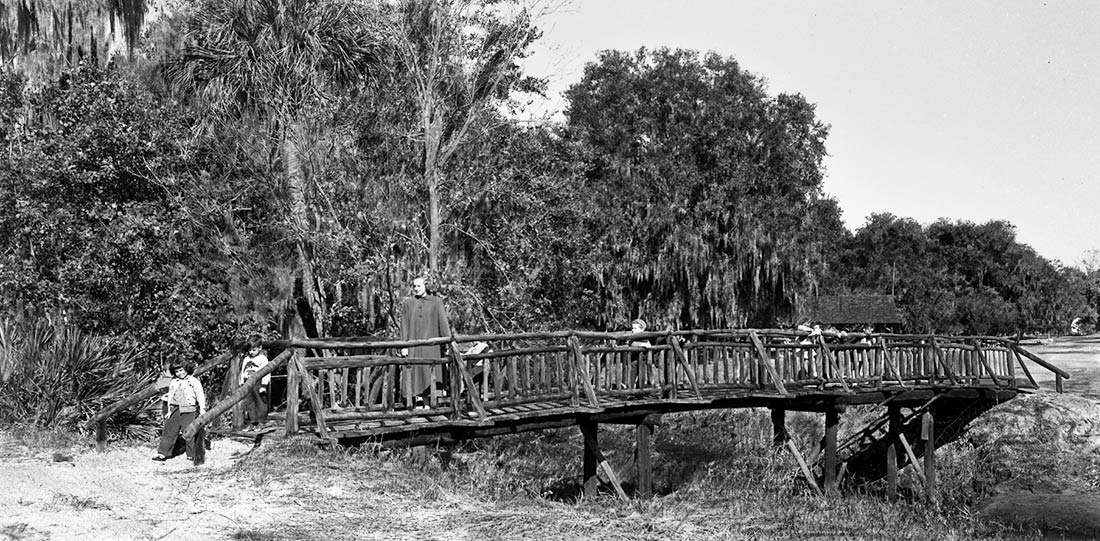
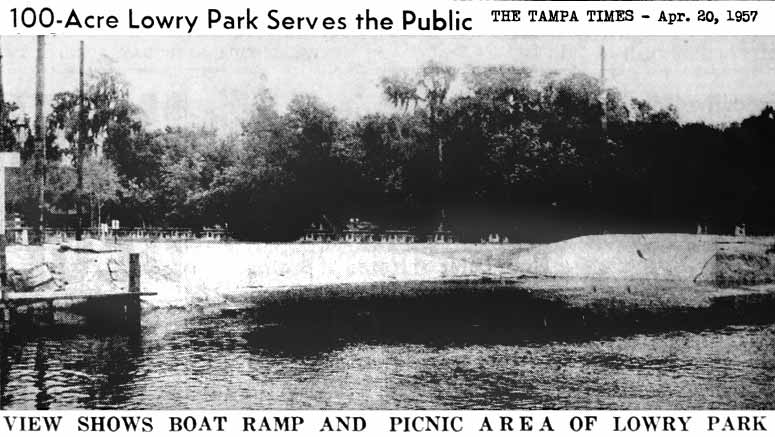
Already, residents along the river in this
area were being disturbed by boaters racing up and down the river.

Before Fairyland, the park's biggest crowds came on days
the City gave away free surplus parks dept. plants. |

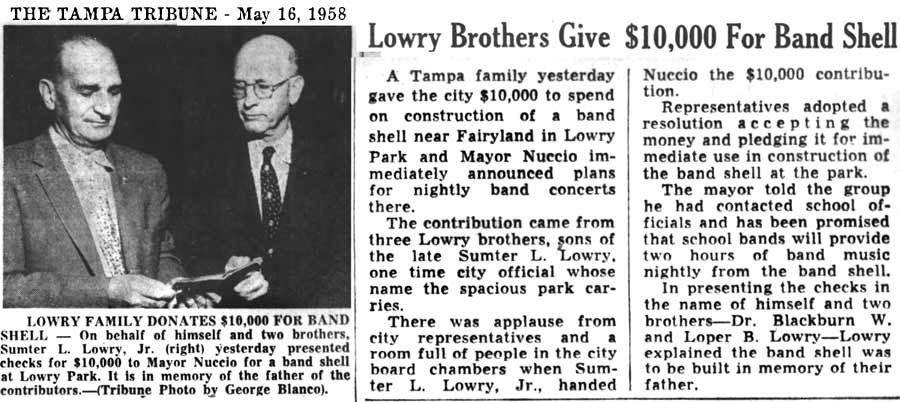
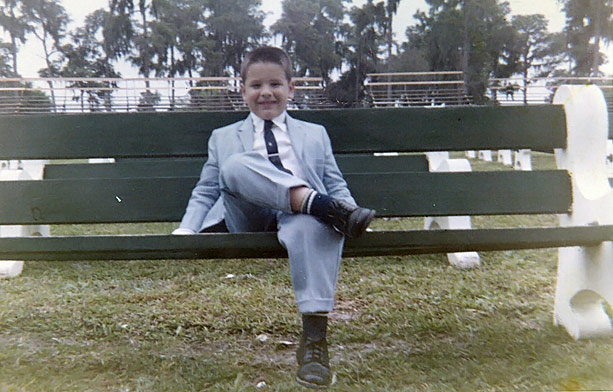
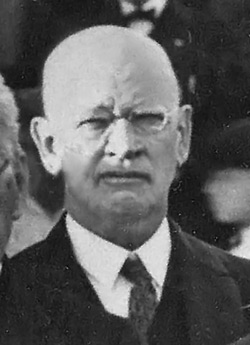
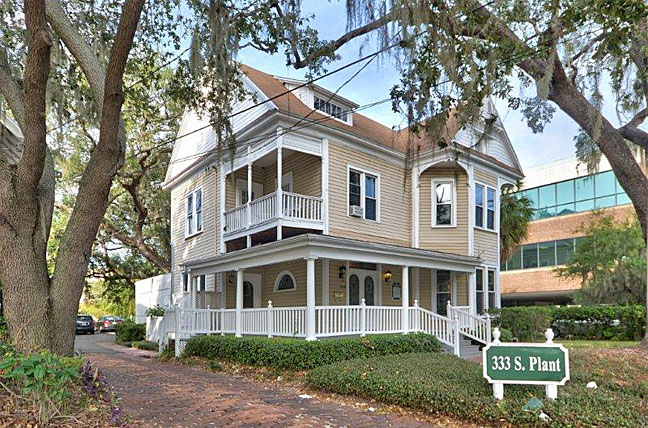

 The Times' lack of punctuation causes ambiguity in the legal
description, and they include an extra measurement which causes the last
two tracts to refer to the same tract of land. By removing the
extra "N½" in the third tract ("B" on the map) and adding parentheses so
that the 2nd and 3rd tracts both refer to the SE¼ of Section 26, the
three tracts combine to form present-day Lowry Park which lies west of
North Blvd and north of Sligh Avenue.
The Times' lack of punctuation causes ambiguity in the legal
description, and they include an extra measurement which causes the last
two tracts to refer to the same tract of land. By removing the
extra "N½" in the third tract ("B" on the map) and adding parentheses so
that the 2nd and 3rd tracts both refer to the SE¼ of Section 26, the
three tracts combine to form present-day Lowry Park which lies west of
North Blvd and north of Sligh Avenue. 
























 In
the years since 1925, the Lowry myth developed. By 1959, in
the midst of racial discrimination and ensuing push for integration
at Tampa's city parks, the press already thought the Lowry family
had donated the land for the park. The "ardent champion of
segregation and states rights" was describing Gen. Sumter Lowry, JR.
In
the years since 1925, the Lowry myth developed. By 1959, in
the midst of racial discrimination and ensuing push for integration
at Tampa's city parks, the press already thought the Lowry family
had donated the land for the park. The "ardent champion of
segregation and states rights" was describing Gen. Sumter Lowry, JR.





















 Mayor Perry
Wall's response to Lowry's suggestion was printed on Dec. 17
in the Tampa Times. Wall's stance was that the city
would not buy a cemetery site before the end of his
administration . "I have no disposition to go into the
purchase of a cemetery at the end of my administration,
unless it can be proven to my satisfaction that the
necessity for purchasing it at this time is absolutely
imperative and that the price for which it is offered is
particularly attractive." The article ends with the
Tribune saying "Dr. Lowry has agitated the purchase of a
piece of land ever since it was learned that Lowry park,
originally bought for that purpose, was unsuited as a burial
ground...the land was too low and seepage of water was too
close to the surface."
Mayor Perry
Wall's response to Lowry's suggestion was printed on Dec. 17
in the Tampa Times. Wall's stance was that the city
would not buy a cemetery site before the end of his
administration . "I have no disposition to go into the
purchase of a cemetery at the end of my administration,
unless it can be proven to my satisfaction that the
necessity for purchasing it at this time is absolutely
imperative and that the price for which it is offered is
particularly attractive." The article ends with the
Tribune saying "Dr. Lowry has agitated the purchase of a
piece of land ever since it was learned that Lowry park,
originally bought for that purpose, was unsuited as a burial
ground...the land was too low and seepage of water was too
close to the surface."







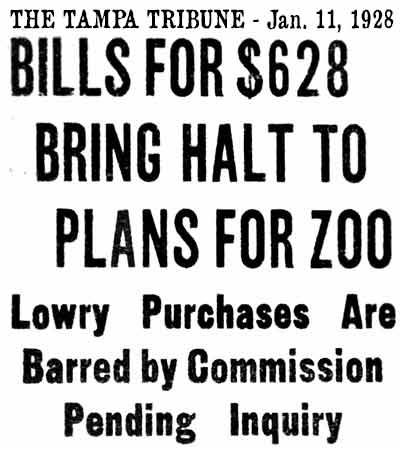
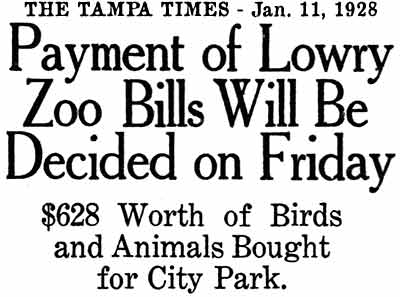




 ADAMS PARK RENAMED JOSEPH ROBLES PARK
- Feb. 14,* 1928
ADAMS PARK RENAMED JOSEPH ROBLES PARK
- Feb. 14,* 1928










